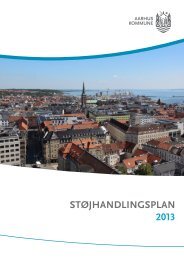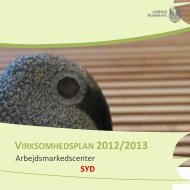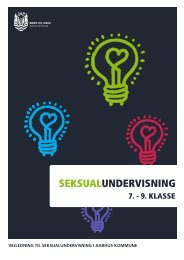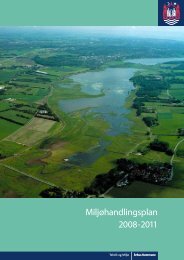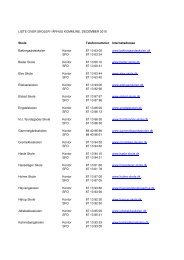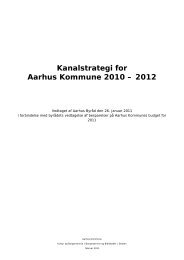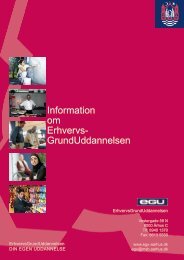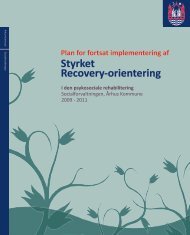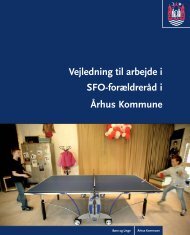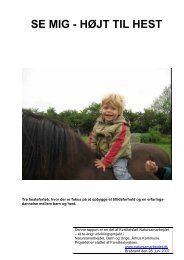Synshandicap Hvad er et synshandicap? - Aarhus.dk
Synshandicap Hvad er et synshandicap? - Aarhus.dk
Synshandicap Hvad er et synshandicap? - Aarhus.dk
You also want an ePaper? Increase the reach of your titles
YUMPU automatically turns print PDFs into web optimized ePapers that Google loves.
Leksikon - <strong>Synshandicap</strong><br />
<strong>Synshandicap</strong><br />
Teksten stamm<strong>er</strong> fra Statens Øjenkliniks hjemmeside, som<br />
findes på adressen: www.visaid.<strong>dk</strong><br />
2004<br />
<strong>Hvad</strong> <strong>er</strong> <strong>et</strong> <strong>synshandicap</strong>?<br />
Nedsat syn ell<strong>er</strong> <strong>synshandicap</strong> vis<strong>er</strong> sig ved, at man ikke læng<strong>er</strong>e<br />
kan skelne d<strong>et</strong>alj<strong>er</strong> på sædvanlig afstand, men skal tætt<strong>er</strong>e på<br />
emn<strong>et</strong>.<br />
Syn<strong>et</strong> måles ved en synsprøve, hvor p<strong>er</strong>sonen præsent<strong>er</strong>es for en<br />
række testsymbol<strong>er</strong> af forskellig størrelse i en bestemt afstand.<br />
Mål<strong>er</strong>esultat<strong>et</strong> angiv<strong>er</strong> en synsstyrke, d<strong>er</strong> som regel udtrykkes med<br />
en brøk. Synsbrøken <strong>er</strong> forhold<strong>et</strong> mellem testp<strong>er</strong>sonens synsafstand<br />
i tæll<strong>er</strong>en og den afstand en tænkt normalp<strong>er</strong>son vil kunne se d<strong>et</strong><br />
samme testsymbol på i nævn<strong>er</strong>en. Eksempel: synsbrøken 6/18<br />
fortæll<strong>er</strong>, at en p<strong>er</strong>son ved en synsprøve på 6 m<strong>et</strong><strong>er</strong>s afstand lige<br />
n<strong>et</strong>op kan se de testsymbol<strong>er</strong>, som en normaltseende kan se på 18<br />
m<strong>et</strong><strong>er</strong>s afstand.<br />
Synsstyrken kan også skrives som <strong>et</strong> decimaltal. Omregningen<br />
mellem synsbrøk og decimaltal fremgår af nedenstående tabel.<br />
Synsbrøk Decimaltal Synsbrøk Decimaltal<br />
6/4,5 1,33 6/20 0,3<br />
6/5 1,2 6/24 0,25<br />
6/6 1,0 6/30 0,2<br />
6/6,7 0,9 6/36 0,17<br />
6/7,5 0,8 6/48 0,125<br />
6/9 0,67 6/60 0,1<br />
6/10 0,6 6/75 0,08<br />
6/12 0,5 3/60 0,05<br />
6/15 0,4 2/60 0,033<br />
6/18 0,33 1/60 0,017<br />
Hvis syn<strong>et</strong> <strong>er</strong> så nedsat, at man ikke læng<strong>er</strong>e kan anvende en<br />
file://C:\Handi-Info (nuværende)\Leksikon\<strong>Synshandicap</strong>.htm<br />
Page 1 of 34<br />
02-02-2009
Leksikon - <strong>Synshandicap</strong><br />
synstavle angives synsresten ved evnen til at tælle fingre på en<br />
hånd foran ansigt<strong>et</strong> (fgt) ell<strong>er</strong> evnen til at skelne håndens<br />
bevægels<strong>er</strong> (hbv). Hvis d<strong>er</strong> kun <strong>er</strong> bevar<strong>et</strong> en opfattelse af lys<br />
angives om lys<strong>et</strong> kan r<strong>et</strong>ningsbestemmes ell<strong>er</strong> ej (lyssans med ell<strong>er</strong><br />
uden projektion).<br />
D<strong>et</strong> <strong>er</strong> en udbredt misforståelse, at stærke brill<strong>er</strong> <strong>er</strong> ensb<strong>et</strong>ydende<br />
med <strong>et</strong> dårligt syn. Nogle mennesk<strong>er</strong> <strong>er</strong> så heldige, at de s<strong>er</strong> normalt<br />
uden brug af brill<strong>er</strong>, andre skal bruge brill<strong>er</strong> for at se skarpt, men<br />
fælles for disse to grupp<strong>er</strong> <strong>er</strong>, at syn<strong>et</strong> med ell<strong>er</strong> uden brill<strong>er</strong> <strong>er</strong><br />
normalt. Med andre ord: brillestyrken har ikke nog<strong>et</strong> med<br />
<strong>synshandicap</strong> at gøre.<br />
D<strong>er</strong> findes forskellige grad<strong>er</strong> af <strong>synshandicap</strong>, som inddeles i<br />
forskellige grupp<strong>er</strong>. Den mest udbredte klassifikation af<br />
<strong>synshandicap</strong> <strong>er</strong> den int<strong>er</strong>nationale WHO klassifikation. Iflg. denne<br />
inddeling regnes man fx først for blind, når synsstyrken <strong>er</strong> und<strong>er</strong><br />
3/60.<br />
I d<strong>et</strong> danske samfund har man siden 1914 an<strong>er</strong>kendt en<br />
blindegrænse på 6/60, og samme grænse anvendes også i mange<br />
andre "rige" lande. D<strong>er</strong>for bruges WHO klassifikationen mest i<br />
videnskabelig sammenhæng og ved int<strong>er</strong>nationale<br />
sammenligning<strong>er</strong>.<br />
Den danske sociale klassifikation af <strong>synshandicap</strong> <strong>er</strong> følgende:<br />
Kategori 0: normalt - l<strong>et</strong>t<strong>er</strong>e nedsat syn >6/18 (0,33)<br />
Kategori A: svagsyn<strong>et</strong>hed £6/18 (0,33) og >6/60 (0,1)<br />
Kategori B: social blindhed £6/60 (0,1) og >1/60 (0,02)<br />
Kategori C: praktisk blindhed£1/60 (0,02)<br />
Kategori D: total blindhed lyssans uden projektion ell<strong>er</strong> ingen<br />
lyssans.<br />
Page 2 of 34<br />
Et <strong>synshandicap</strong> kan ud ov<strong>er</strong> synsnedsættelse bestå i <strong>et</strong> ødelagt<br />
sidesyn. H<strong>er</strong>ved mistes orient<strong>er</strong>ingsevnen. Sidesyn<strong>et</strong>,<br />
orient<strong>er</strong>ingssyn<strong>et</strong> ell<strong>er</strong> d<strong>et</strong> p<strong>er</strong>if<strong>er</strong>e syn <strong>er</strong> alle b<strong>et</strong>egnels<strong>er</strong> for d<strong>et</strong><br />
samme og måles ved en optegnelse af synsfelt<strong>et</strong>. En ligelig<br />
indskrænkning af synsfelt<strong>et</strong> til 10° ell<strong>er</strong> d<strong>er</strong>und<strong>er</strong> kaldes "kikk<strong>er</strong>tsyn".<br />
Hvis synsfelt<strong>et</strong> <strong>er</strong> und<strong>er</strong> 10° vurd<strong>er</strong>es <strong>synshandicap</strong>p<strong>et</strong> sv.t. kategori<br />
file://C:\Handi-Info (nuværende)\Leksikon\<strong>Synshandicap</strong>.htm<br />
02-02-2009
Leksikon - <strong>Synshandicap</strong><br />
Page 3 of 34<br />
C uans<strong>et</strong> hvor god synsstyrken <strong>er</strong>. Andre form<strong>er</strong> for<br />
synsfeltspåvirkning kan også ændre vurd<strong>er</strong>ingen af hvor alvorligt <strong>et</strong><br />
<strong>synshandicap</strong> <strong>er</strong>.<br />
Andre dele af synssansen kan være ramt f.eks. farvesansen ell<strong>er</strong><br />
mørkesyn<strong>et</strong>. Sygdomsb<strong>et</strong>ing<strong>et</strong> lysov<strong>er</strong>følsomhed kan være stærkt<br />
invalid<strong>er</strong>ende, og manglende evne til at styre øjnene ell<strong>er</strong><br />
vedvarende dobbeltsyn <strong>er</strong> andre form<strong>er</strong> for <strong>synshandicap</strong>.<br />
Årsag<strong>er</strong> til <strong>synshandicap</strong> i Danmark<br />
Man regn<strong>er</strong> med, at ca. 1% af befolkningen, dvs. omkring 50.000<br />
dansk<strong>er</strong>e, har en synsnedsættelse til 6/18 ell<strong>er</strong> d<strong>er</strong>und<strong>er</strong>. D<strong>et</strong><br />
ov<strong>er</strong>vejende fl<strong>er</strong>tal <strong>er</strong> ov<strong>er</strong> 60 år gamle og <strong>er</strong> ramt af ald<strong>er</strong>sb<strong>et</strong>ing<strong>et</strong><br />
synssvækkelse i n<strong>et</strong>hindens gule pl<strong>et</strong>. Denne lidelse b<strong>et</strong>egnes<br />
makuladegen<strong>er</strong>ation (AMD) og <strong>er</strong> i dag langt den almindeligste<br />
årsag til <strong>synshandicap</strong> i den vestlige v<strong>er</strong>den. Grøn stær <strong>er</strong> en anden<br />
øjensygdom, som især ramm<strong>er</strong> ældre. Blandt yngre voksne <strong>er</strong><br />
sukk<strong>er</strong>syge blandt de almindeligste årsag<strong>er</strong> til synssvækkelse.<br />
H<strong>er</strong>eft<strong>er</strong> komm<strong>er</strong> synsn<strong>er</strong>velidels<strong>er</strong>, arvelige n<strong>et</strong>hindelidels<strong>er</strong>, stærk<br />
nærsyn<strong>et</strong>hed og årehindeb<strong>et</strong>ændelse med aftagende hyppighed.<br />
Blandt børn og unge <strong>er</strong> billed<strong>et</strong> meg<strong>et</strong> brog<strong>et</strong> med en lang række<br />
medfødte udviklingsfejl, fødselsskad<strong>er</strong> og forskellige arvelige<br />
lidels<strong>er</strong>. Takk<strong>et</strong> være Synsregist<strong>er</strong><strong>et</strong> ved vi mest om <strong>synshandicap</strong> i<br />
barneald<strong>er</strong>en. Læs nærm<strong>er</strong>e h<strong>er</strong>om i Årsb<strong>er</strong><strong>et</strong>ning fra<br />
Synsregist<strong>er</strong><strong>et</strong>.<br />
Beskrivelse af øjensygdomme<br />
Mange af de øjensygdomme, som medfør<strong>er</strong> alvorligt <strong>synshandicap</strong><br />
tidligt i liv<strong>et</strong> <strong>er</strong> meg<strong>et</strong> sjældne, og d<strong>et</strong> kan være svært at finde<br />
file://C:\Handi-Info (nuværende)\Leksikon\<strong>Synshandicap</strong>.htm<br />
02-02-2009
Leksikon - <strong>Synshandicap</strong><br />
oplysning<strong>er</strong> om dem på dansk.<br />
Statens Øjenklinik har påbegyndt en s<strong>er</strong>ie af sygdomsbeskrivels<strong>er</strong> af<br />
nogle af disse øjenlidels<strong>er</strong>, d<strong>er</strong> som regel <strong>er</strong> arvelige.<br />
Information om Øjensygdomme:<br />
Leb<strong>er</strong>´s h<strong>er</strong>editære opticus neuropathi<br />
Page 4 of 34<br />
Leb<strong>er</strong>'s h<strong>er</strong>editære opticus neuropathi (LHON) <strong>er</strong> en arvelig<br />
øjensygdom, d<strong>er</strong> ramm<strong>er</strong> begge synsn<strong>er</strong>v<strong>er</strong> og medfør<strong>er</strong> en hurtigt<br />
indtrædende, alvorlig og blivende synsnedsættelse. Den ramm<strong>er</strong><br />
oftest yngre voksne p<strong>er</strong>son<strong>er</strong> og ses ca. 4 gange så hyppigt hos<br />
mænd som hos kvind<strong>er</strong>.<br />
Sygdommen har få<strong>et</strong> navn eft<strong>er</strong> den tyske øjenlæge T. Leb<strong>er</strong> d<strong>er</strong><br />
beskrev den m<strong>er</strong>e indgående i 1871.<br />
I Danmark <strong>er</strong> d<strong>et</strong> primært øjenlæge R. Lundsgaards monografi fra<br />
1944, d<strong>er</strong> har gjort denne sjældne og mærkelige synsn<strong>er</strong>velidelse<br />
kendt. Hendes arbejde <strong>er</strong> sen<strong>er</strong>e vid<strong>er</strong>eført af øjenlæge T. Seedorff i<br />
1968-1985.<br />
Disse arbejd<strong>er</strong> b<strong>et</strong>yd<strong>er</strong>, at vi i Danmark <strong>er</strong> i den enestående<br />
situation, at d<strong>et</strong> på Statens Øjenklinik <strong>er</strong> lykkedes at opbygge <strong>et</strong><br />
regist<strong>er</strong> med alle nuværende kendte slægt<strong>er</strong>, hvilk<strong>et</strong> indgår i Dansk<br />
Familiearkiv for Arvelige Øjensygdomme. H<strong>er</strong>ved kendes d<strong>er</strong>es<br />
udbredelse og antall<strong>et</strong> af p<strong>er</strong>son<strong>er</strong> d<strong>er</strong> har få<strong>et</strong> sygdommen.<br />
D<strong>er</strong> <strong>er</strong> i Danmark registr<strong>er</strong><strong>et</strong> ialt 51 slægt<strong>er</strong> med sammenlagt 319<br />
tilfælde fordelt på 261 mænd (81,8%) og 58 kvind<strong>er</strong> (18,2%) (1995).<br />
D<strong>et</strong>te svar<strong>er</strong> til, at d<strong>er</strong> i gennemsnit opstår ca. 3 nye tilfælde om år<strong>et</strong>.<br />
Lidt forbavsende har man konstat<strong>er</strong><strong>et</strong>, at forhold<strong>et</strong> mellem mænd og<br />
kvind<strong>er</strong> gennem de sen<strong>er</strong>e år har ændr<strong>et</strong> sig, således at antall<strong>et</strong> af<br />
kvind<strong>er</strong> <strong>er</strong> øg<strong>et</strong> i forhold til mænd. Om d<strong>et</strong>te skyldes ændring i miljø<br />
og levemåde ell<strong>er</strong> blot tilfældighed<strong>er</strong> <strong>er</strong> d<strong>et</strong> ikke muligt at udtale sig<br />
om med sikk<strong>er</strong>hed.<br />
Arvegang og årsag:<br />
Arvegangen har gennem mange år påkaldt sig særlig int<strong>er</strong>esse, da<br />
file://C:\Handi-Info (nuværende)\Leksikon\<strong>Synshandicap</strong>.htm<br />
02-02-2009
Leksikon - <strong>Synshandicap</strong><br />
den har adskilt sig markant fra andre arvelige lidels<strong>er</strong>, ved at<br />
sygdomsanlægg<strong>et</strong> (DNA-forandring, mutation) udelukkende<br />
vid<strong>er</strong>eføres gennem kvind<strong>er</strong>ne. D<strong>et</strong>te <strong>er</strong> ikke foreneligt med klassisk<br />
mendelsk arvegang.<br />
Ved mendelsk arvegang <strong>er</strong> sygdomsanlæggene beliggende i<br />
cellek<strong>er</strong>nen og vid<strong>er</strong>eføres både gennem mænd og kvind<strong>er</strong> eft<strong>er</strong><br />
bestemte regl<strong>er</strong> (recessiv, dominant og x-bunden arvegang).<br />
I 1988 blev gåden dog løst da D.C. Wallace påviste, at d<strong>et</strong> drejede<br />
sig om såkaldt "mitokondriel arvegang".<br />
Ved mitokondriel arvegang <strong>er</strong> sygdomsanlæggene beliggende i<br />
mitokondri<strong>er</strong>ne, den eneste DNA-holdige cellebestanddel udov<strong>er</strong><br />
k<strong>er</strong>nen. Denne beskedne, men uundværlige del af arvemassen<br />
vid<strong>er</strong>eføres alene via ægcell<strong>er</strong>ne, id<strong>et</strong> sædcell<strong>er</strong>ne udelukkende<br />
bidrag<strong>er</strong> med k<strong>er</strong>ne - DNA.<br />
D<strong>et</strong>te forklarede således ikke blot, at anlægg<strong>et</strong> vid<strong>er</strong>eføres gennem<br />
kvind<strong>er</strong>ne, men gjorde d<strong>et</strong> også muligt at bestemme<br />
tilstedeværelsen af anlægg<strong>et</strong> ved en blodprøve.<br />
Sen<strong>er</strong>e <strong>er</strong> d<strong>er</strong> fund<strong>et</strong> fl<strong>er</strong>e mutation<strong>er</strong>, og indtil dato <strong>er</strong> d<strong>er</strong> fund<strong>et</strong> i alt<br />
18 forskellige mutation<strong>er</strong> d<strong>er</strong> alene ell<strong>er</strong> i kombination kan forårsage<br />
sygdommen. De vigtigste benævnes ND4 (11778), ND1 (3460) og<br />
ND6 (14484) og disse udgør tilsammen 90% af alle<br />
tilfælde.Und<strong>er</strong>søgelse h<strong>er</strong>for kan for<strong>et</strong>ages på klinisk - gen<strong>et</strong>isk<br />
afdeling, Rigshospital<strong>et</strong>.<br />
I Danmark har man ved und<strong>er</strong>søgelse af 30 slægt<strong>er</strong> med nulevende<br />
sygdomsramte, påvist tilstedeværelsen ND4 (11778) i 26 slægt<strong>er</strong>,<br />
ND1 (3460) i 3 slægt<strong>er</strong> samt ND6 (14484) i 1 slægt.<br />
Denne specielle arvegang gør d<strong>et</strong> særdeles vanskeligt at give<br />
patient<strong>er</strong> og d<strong>er</strong>es slægtninge rådgivning omkring risiko for<br />
nedarvning.<br />
Følgende hovedtræk kan dog nævnes:<br />
Anlægg<strong>et</strong> vid<strong>er</strong>eføres gennem kvinden til alle hendes børn.<br />
Anlægg<strong>et</strong> kan ikke vid<strong>er</strong>eføres gennem mænd.<br />
Sønn<strong>er</strong> har b<strong>et</strong>ydelig større risiko end døtre for at få<br />
file://C:\Handi-Info (nuværende)\Leksikon\<strong>Synshandicap</strong>.htm<br />
Page 5 of 34<br />
02-02-2009
Leksikon - <strong>Synshandicap</strong><br />
sygdommen, ca.50% mod ca.15-20%.<br />
Når ikke alle anlægsbær<strong>er</strong>e får sygdommen, skyldes d<strong>et</strong> nedsat<br />
gennemslagskraft af anlægg<strong>et</strong>. En sikk<strong>er</strong> viden om årsagen h<strong>er</strong>til<br />
har man ikke, men d<strong>et</strong> <strong>er</strong> dog gængs opfattelse at <strong>et</strong> øg<strong>et</strong> forbrug af<br />
alkohol, tobak og cyanidholdige fødeemn<strong>er</strong> (f.eks. mandl<strong>er</strong>) kan<br />
være med til at udløse sygdommen.<br />
Vores viden om de biokemiske forandring<strong>er</strong>, som sygdomsanlægg<strong>et</strong><br />
medfør<strong>er</strong>, <strong>er</strong> endnu sparsomme. Und<strong>er</strong>søgels<strong>er</strong> peg<strong>er</strong> dog i r<strong>et</strong>ning<br />
af, at d<strong>er</strong> sk<strong>er</strong> ændring<strong>er</strong> i organismens en<strong>er</strong>gistofskifte.<br />
Man har konstat<strong>er</strong><strong>et</strong>, at de tre nævnte sygdomsanlæg medfør<strong>er</strong><br />
aminosyreændring<strong>er</strong> i forskellige und<strong>er</strong>enhed<strong>er</strong> af d<strong>et</strong> såkaldte<br />
komplex 1 (NADH - ubiquinon oxido-reduktase).<br />
B<strong>et</strong>ydningen h<strong>er</strong>af <strong>er</strong> endnu ukendt, så den egentlige årsag til LHON<br />
må afvente yd<strong>er</strong>lig<strong>er</strong>e forskning.<br />
Symptom<strong>er</strong>:<br />
I langt de fleste tilfælde vil sygdommen komme til udbrud i 20-40 års<br />
ald<strong>er</strong>en, men d<strong>er</strong> <strong>er</strong> s<strong>et</strong> tilfælde både hos børn und<strong>er</strong> 10 år og ældre<br />
ov<strong>er</strong> 60 år.<br />
1. Nedsat centralsyn: Synstab<strong>et</strong> kan vari<strong>er</strong>e, men ofte ses <strong>et</strong> udtalt<br />
synstab med få dage til ug<strong>er</strong>s tidsforskydning mellem de to øjne.<br />
H<strong>er</strong>eft<strong>er</strong> mod<strong>er</strong>at bedring og stabilis<strong>er</strong>ing sluttende med <strong>et</strong> niveau<br />
beliggende omkring 1/60 - 3/60 eft<strong>er</strong> 1 år. I enkelte slægt<strong>er</strong> <strong>er</strong> d<strong>er</strong><br />
dog beskrev<strong>et</strong> <strong>et</strong> væsentlig bedre slutniveau, sågar normalis<strong>er</strong>ing af<br />
syn<strong>et</strong> i få tilfælde.<br />
En svær nedsættelse af centralsyn<strong>et</strong> medfør<strong>er</strong> bl.a. alvorlige<br />
læseproblem<strong>er</strong>, svært ved at se fj<strong>er</strong>nsyn og svært ved at genkende<br />
p<strong>er</strong>son<strong>er</strong>.<br />
2.Synsfeltdefekt: Ved und<strong>er</strong>søgelse af synsfelt<strong>et</strong> findes ofte en<br />
central synsfeltdefekt af ca. 10-25 grad<strong>er</strong>s størrelse, mens<br />
yd<strong>er</strong>græns<strong>er</strong>ne <strong>er</strong> fuldstændige normale (Fig. 1).<br />
Page 6 of 34<br />
Sidstnævnte medfør<strong>er</strong> at en angreben p<strong>er</strong>son til trods for den svære<br />
nedsættelse af centralsyn<strong>et</strong> <strong>er</strong> istand til at færdes og orient<strong>er</strong>e sig<br />
uden de store problem<strong>er</strong>.<br />
file://C:\Handi-Info (nuværende)\Leksikon\<strong>Synshandicap</strong>.htm<br />
02-02-2009
Leksikon - <strong>Synshandicap</strong><br />
3. Farvesyn: I næsten alle tilfælde findes en påvirkning af<br />
farvesyn<strong>et</strong>. Denne kan være af vekslende sværhedsgrad og<br />
afhængig h<strong>er</strong>af vil d<strong>er</strong> være problem<strong>er</strong> med at skelne farv<strong>er</strong>.<br />
Page 7 of 34<br />
4. Synsn<strong>er</strong>veforandring: Ved sygdommens start vil øjenlægen ofte<br />
finde, at synsn<strong>er</strong>ven virk<strong>er</strong> lidt hæv<strong>et</strong>, rødmoss<strong>et</strong> og med <strong>et</strong> øg<strong>et</strong><br />
antal små blo<strong>dk</strong>ar i kanten ( Fig. 2.) D<strong>et</strong>te vil i løb<strong>et</strong> af måned<strong>er</strong><br />
forsvinde og afløses af en tiltagende afblegning i takt med, at de<br />
enkelte n<strong>er</strong>v<strong>et</strong>råde går til grunde ( Fig.3.)<br />
5. VEP -forandring<strong>er</strong>: VEP (Visual Evoked Pontential) <strong>er</strong> en<br />
und<strong>er</strong>søgelse, d<strong>er</strong> vis<strong>er</strong>, hvordan synsn<strong>er</strong>ven fung<strong>er</strong><strong>er</strong>. Denne<br />
und<strong>er</strong>søgelse vil ofte vise forandring<strong>er</strong> og d<strong>er</strong>med bekræfte, at d<strong>er</strong><br />
foreligg<strong>er</strong> en påvirkning af synsn<strong>er</strong>v<strong>er</strong>ne. D<strong>et</strong>te kan være vigtigt i<br />
begyndelsesfasen, hvor forandring<strong>er</strong>ne af synsn<strong>er</strong>v<strong>er</strong>ne kan være<br />
vanskelig at se for øjenlægen.<br />
Selve und<strong>er</strong>søgelsen <strong>er</strong> hurtig og uden ulemp<strong>er</strong>. Patienten<br />
stimul<strong>er</strong>es med enten stærke lysglimt ell<strong>er</strong> via skakmønst<strong>er</strong> på en<br />
fj<strong>er</strong>nsynsskærm. D<strong>et</strong>te vil medføre dannelse af elektriske impuls<strong>er</strong>,<br />
d<strong>er</strong> kan afledes via elektrod<strong>er</strong> plac<strong>er</strong><strong>et</strong> på hårbunden ov<strong>er</strong><br />
synsbarken og registr<strong>er</strong>es på en skærm. Forandring<strong>er</strong>ne kan bestå<br />
enten i forlæng<strong>et</strong> ov<strong>er</strong>ledning ell<strong>er</strong> ændring i kurveformen.<br />
6. Almensymptom<strong>er</strong>: I langt de fleste tilfælde <strong>er</strong> synstab<strong>et</strong> d<strong>et</strong> eneste<br />
file://C:\Handi-Info (nuværende)\Leksikon\<strong>Synshandicap</strong>.htm<br />
02-02-2009
Leksikon - <strong>Synshandicap</strong><br />
symptom hos patient<strong>er</strong> med LHON. D<strong>er</strong> <strong>er</strong> dog beskrev<strong>et</strong> slægt<strong>er</strong><br />
med en øg<strong>et</strong> hyppighed af f.eks hj<strong>er</strong>tesymptom<strong>er</strong> og neurologiske<br />
lidels<strong>er</strong>.<br />
Behandling:<br />
Medicinsk forebyggelse, endsige behandling <strong>er</strong> endnu ikke mulig.<br />
Synstab<strong>et</strong> kan måske forhindres ell<strong>er</strong> forsinkes, hvis man undgår<br />
særlige stofskiftebelastning<strong>er</strong> som tobaksrygning, alkohol samt<br />
indtagelse af bestemte fødemidl<strong>er</strong>. D<strong>er</strong> h<strong>er</strong>sk<strong>er</strong> dog stor usikk<strong>er</strong>hed<br />
omkring d<strong>et</strong>te.<br />
D<strong>er</strong> foregår til stadighed forskning for at udvide kendskab<strong>et</strong> til de<br />
sygdomsfremkaldende arveanlæg og d<strong>er</strong>es indvirkning på<br />
en<strong>er</strong>gistofskift<strong>et</strong>. D<strong>er</strong> <strong>er</strong> håb om, at man på læng<strong>er</strong>e sigt vil blive<br />
istand til at forhindre, at sygdommen komm<strong>er</strong> til udbrud ved<br />
forebyggende behandling.<br />
Den manglende behandling b<strong>et</strong>yd<strong>er</strong> dog ikke, at man <strong>er</strong> fuldstændig<br />
magtesløs. D<strong>er</strong> vil være en lang række mulighed<strong>er</strong>, hvormed<br />
problem<strong>er</strong>ne i forbindelse med synstab<strong>et</strong> kan afhjælpes og mildnes.<br />
Blandt and<strong>et</strong> kan nævnes af landsdækkende tilbud :<br />
1. Statens Øjenklinik:<br />
Afprøvning af svagsynsoptik (lupp<strong>er</strong>, lupbrill<strong>er</strong>, kikk<strong>er</strong>t<strong>er</strong>,<br />
filt<strong>er</strong>glas <strong>et</strong>c.)<br />
Vurd<strong>er</strong>ing af synstab<strong>et</strong>s omfang og b<strong>et</strong>ydning for fremtiden ,<br />
samt gen<strong>et</strong>isk vejledning. Ligeledes vil d<strong>er</strong> ske en vurd<strong>er</strong>ing af, i<br />
hvilk<strong>et</strong> omfang synstab<strong>et</strong> b<strong>er</strong><strong>et</strong>tig<strong>er</strong> til sociale ydels<strong>er</strong> som f.eks.<br />
helbredsb<strong>et</strong>ing<strong>et</strong> førtidspension, invalidit<strong>et</strong>sydelse og<br />
bistandstillæg.<br />
2. Institutt<strong>et</strong> for Blinde og Svagsynede:<br />
Hjælpemiddelafprøvning (CCTV apparat hvormed man <strong>er</strong> istand<br />
til at fostørre tekst op på skærm, EDB, synt<strong>et</strong>isk tale, lys <strong>et</strong>c. )<br />
<strong>Synshandicap</strong>kompens<strong>er</strong>ende kurs<strong>er</strong>.<br />
Vurd<strong>er</strong>ing af revalid<strong>er</strong>ingsmulighed<strong>er</strong>.<br />
Rådgivning og vejledning.<br />
file://C:\Handi-Info (nuværende)\Leksikon\<strong>Synshandicap</strong>.htm<br />
Page 8 of 34<br />
02-02-2009
Leksikon - <strong>Synshandicap</strong><br />
3. Dansk Blindesamfund:<br />
Rådgivning og vejledning via blindekonsulent i hjemm<strong>et</strong>. D<strong>et</strong>te<br />
kan følges op af omsorgskonsulent<strong>er</strong>, d<strong>er</strong> blandt and<strong>et</strong> kan<br />
ledsage til mød<strong>er</strong> og aflægge hjemmebesøg<br />
Kurs<strong>er</strong> og arrangement<strong>er</strong> d<strong>er</strong> både kan have<br />
handicapkompens<strong>er</strong>ende sigte, men også indebær<strong>er</strong> at man<br />
mød<strong>er</strong> andre mennesk<strong>er</strong> med <strong>synshandicap</strong>.<br />
4. Danmarks Blindebibliotek:<br />
Produc<strong>er</strong><strong>er</strong> og udlån<strong>er</strong> båndbøg<strong>er</strong>, punktbøg<strong>er</strong> og nod<strong>er</strong> samt<br />
tidsskrift<strong>er</strong>. Desuden udgives en landsdækkende lydavis.<br />
D<strong>et</strong>te var kort nogle af de landsdækkende mulighed<strong>er</strong> d<strong>er</strong> foreligg<strong>er</strong>,<br />
men også lokalt i de enkelte amt<strong>er</strong> findes d<strong>er</strong> hjælpemiddelcentral<strong>er</strong>,<br />
synscentral<strong>er</strong> og synskonsulent<strong>er</strong> med viden og <strong>er</strong>faring indenfor<br />
d<strong>et</strong>te område.<br />
Litt<strong>er</strong>atur:<br />
1. Lundsgaard R. Leb<strong>er</strong>'s disease. A genealogic, gen<strong>et</strong>ic, and<br />
clinical study of 101 cases of r<strong>et</strong>robulbar optic neuritis in 20 Danish<br />
families. København: Gyldendalske Boghandel - Nordisk Forlag,<br />
1944. Disp.<br />
2. Seedorff T. The inh<strong>er</strong>itance of Leb<strong>er</strong>'s disease. A genealogic<br />
followup study. Acta Ophthalmol 1985; 135-45.<br />
3. Wallace DC, Singh G, Lott MT <strong>et</strong> al. Mithokondrial DNA mutation<br />
associated with Leb<strong>er</strong>'s h<strong>er</strong>editary optic neuropathy. Science 1988;<br />
242:1427-30.<br />
4. Nørby S, Rosenb<strong>er</strong>g T. Leb<strong>er</strong>'s h<strong>er</strong>editære opticusatrofi. En<br />
arvelig sygdom d<strong>er</strong> skyldes mitokondrie - DNA mutation.<br />
Ugeskr.Læg<strong>er</strong> 1990; 3149-52.<br />
5. Rosenb<strong>er</strong>g T, Kann E, Nørby S. H<strong>er</strong>editær opticusatrofi. En klinisk<br />
- genealogisk status ov<strong>er</strong> danske "Leb<strong>er</strong>-slægt<strong>er</strong>". Ugeskr.Læg<strong>er</strong><br />
1995;157:2707-11.<br />
Adress<strong>er</strong>:<br />
file://C:\Handi-Info (nuværende)\Leksikon\<strong>Synshandicap</strong>.htm<br />
Page 9 of 34<br />
02-02-2009
Leksikon - <strong>Synshandicap</strong><br />
1) Statens Øjenklinik, Rymarksvej 1, 2900 Hell<strong>er</strong>up, Tlf. 39 45 24 00<br />
2) Institutt<strong>et</strong> for Blinde og Svagsynede, Rymarksvej 1, 2900 Hell<strong>er</strong>up<br />
Tlf. 3945 2545<br />
3) Dansk Blindesamfund, Thoravej 35, 2400 København NV, Tlf. 38<br />
148844<br />
4) Rigshospital<strong>et</strong>, Juliane Marie Centr<strong>et</strong>, Afsnit for Klinisk Gen<strong>et</strong>ik<br />
4062 2100 København Ø. Tlf. 35 454863<br />
5) Danmarks Blindebibliotek, Teglværksvej 37, 2100 København Ø.<br />
Tlf. 39 274444<br />
Information om Øjensygdomme:<br />
Dominant opticus atrofi<br />
Page 10 of 34<br />
Dominant opticus atrofi ( DOA ) <strong>er</strong> en arvelig øjensygdom, d<strong>er</strong><br />
ramm<strong>er</strong> begge synsn<strong>er</strong>v<strong>er</strong> i barneårene og medfør<strong>er</strong> en mild til svær<br />
synsnedsættelse med risiko for l<strong>et</strong> forværring gennem årene.<br />
Omkring 1900-tall<strong>et</strong> begyndte man at blive opmærksom på denne<br />
sygdom, og d<strong>er</strong> fremkom på d<strong>et</strong>te tidspunkt spredte artikl<strong>er</strong>, d<strong>er</strong><br />
beskrev famili<strong>er</strong>, hvori d<strong>er</strong> forekom synsn<strong>er</strong>vepåvirkning med<br />
tilsyneladende dominant arvegang.<br />
Først omkring midten af 1900-tall<strong>et</strong> fremkom d<strong>er</strong>, bl.a. fra danske<br />
øjenlæg<strong>er</strong>, særdeles grundige beskrivels<strong>er</strong>, d<strong>er</strong> medførte, at<br />
sygdommen med sikk<strong>er</strong>hed blev <strong>er</strong>kendt som en selvstændig<br />
øjenlidelse. H<strong>er</strong> skal blot nævnes Lodb<strong>er</strong>g og Lund`s studium fra<br />
1950 og P .Kj<strong>er</strong>`s doktordisputats fra 1956. Sidstnævntes arbejde<br />
har bl.a medført at sygdommen ikke blot i Danmark, men også<br />
int<strong>er</strong>nationalt ofte benævnes "Kj<strong>er</strong>`s dominante opticusatrofi".<br />
Igennem de sen<strong>er</strong>e år har forskningen hovedsagelig tag<strong>et</strong> sigte på<br />
at lokalis<strong>er</strong>e arveanlægg<strong>et</strong> og også h<strong>er</strong> <strong>er</strong> vi i Danmark langt<br />
fremme, id<strong>et</strong> H. Eib<strong>er</strong>g i samarbejde med B. Kj<strong>er</strong>,P.Kj<strong>er</strong> og<br />
T.Rosenb<strong>er</strong>g i 1994 har fund<strong>et</strong> d<strong>et</strong>te til at være beliggende på<br />
kromosom 3.<br />
Som inden for andre arvelige øjensygdomme hvor danske<br />
øjenlæg<strong>er</strong> har vær<strong>et</strong> involv<strong>er</strong><strong>et</strong>, har d<strong>et</strong> vær<strong>et</strong> muligt at samle alle<br />
kendte slægt<strong>er</strong> i Dansk Familiearkiv for Arvelige Øjensygdomme på<br />
Statens Øjenklinik i Hell<strong>er</strong>up. D<strong>et</strong>te har stor b<strong>et</strong>ydning, da d<strong>et</strong> giv<strong>er</strong><br />
file://C:\Handi-Info (nuværende)\Leksikon\<strong>Synshandicap</strong>.htm<br />
02-02-2009
Leksikon - <strong>Synshandicap</strong><br />
Page 11 of 34<br />
mulighed for bedre og hurtig<strong>er</strong>e diagnostik, kortlægning af<br />
udbredningen samt ikke mindst mulighed for at <strong>et</strong>abl<strong>er</strong>e relevante<br />
forskningsprojekt<strong>er</strong>. Specielt sidstnævnte må siges at være vigtigt,<br />
da man forsat ikke kan tilbyde behandling for denne sygdom.<br />
D<strong>er</strong> <strong>er</strong> i Danmark ( 1996 ) registr<strong>er</strong><strong>et</strong> ialt 76 slægt<strong>er</strong> med tilsammen<br />
575 (266 kvind<strong>er</strong> / 309 mænd ) p<strong>er</strong>son<strong>er</strong> med DOA , svarende til at<br />
ca. 1 ud af 10000 i befolkningen har denne sygdom. Disse tal må<br />
formodes at være minimums tal, da fl<strong>er</strong>e slægt<strong>er</strong> ikke <strong>er</strong> fuldstædigt<br />
udredt på nuværende tidspunkt, ejhell<strong>er</strong> kan man forvente at alle ,<br />
specielt yngre, endnu har få<strong>et</strong> still<strong>et</strong> diagnosen.<br />
D<strong>er</strong>med <strong>er</strong> denne sygdom en af de hyppigste arvelige<br />
øjensygdomme i Danmark og lidt forbavsende <strong>er</strong> tall<strong>et</strong> langt høj<strong>er</strong>e<br />
end hvad man angiv<strong>er</strong> int<strong>er</strong>nationalt ( ca. 1/50000 ). Om d<strong>et</strong>te<br />
skyldes en reel forskel ell<strong>er</strong> blot udtryk for bedre opsporing i<br />
Danmark vides ikke.<br />
Arvegang og årsag:<br />
Sygdommen nedarves autosomalt dominant, d.v.s. at d<strong>er</strong> blot skal <strong>et</strong><br />
sygdomsanlæg ( DNA-forandring, mutation ) til, for at sygdommen<br />
kan vise sig. Risikoen for at en p<strong>er</strong>son med DOA vid<strong>er</strong>efør<strong>er</strong><br />
sygdommen til næste gen<strong>er</strong>ation vil d<strong>er</strong>for være 50% ,uans<strong>et</strong> om d<strong>et</strong><br />
bliv<strong>er</strong> en dreng ell<strong>er</strong> pige.<br />
D<strong>er</strong> foreligg<strong>er</strong> stort s<strong>et</strong> fuld gennemslagskraft ( pen<strong>et</strong>rans ) hvilk<strong>et</strong> vil<br />
sige, at alle med arveanlægg<strong>et</strong> vil få sygdommen . Dog kan<br />
symptom<strong>er</strong>ne i enkelte tilfælde være så l<strong>et</strong>te, at man ikke med<br />
sikk<strong>er</strong>hed kan påvise forandring<strong>er</strong>,hvilk<strong>et</strong> <strong>er</strong> årsagen til, at man i<br />
visse famili<strong>er</strong> kan se "ov<strong>er</strong>spring" af en gen<strong>er</strong>ation.<br />
Gennem de sen<strong>er</strong>e år <strong>er</strong> d<strong>er</strong> h<strong>er</strong> i Danmark ved <strong>et</strong> samarbejde<br />
mellem Statens Øjenklinik og Institut for Medicinsk Biokemi og<br />
Gen<strong>et</strong>ik, Københavns Univ<strong>er</strong>sit<strong>et</strong> lykkedes med stor sandsynlighed,<br />
at lokalis<strong>er</strong>e arveanlægg<strong>et</strong> til den lange arm af kromosom 3. Man<br />
mangl<strong>er</strong> dog endnu at finde den præcise lokalisation af mutationen.<br />
På grundlag af kendskab<strong>et</strong> til lokalisationen kan man all<strong>er</strong>ede med<br />
høj sikk<strong>er</strong>hed af- ell<strong>er</strong> bekræfte diagnosen i en blodprøve ell<strong>er</strong> i en<br />
mod<strong>er</strong>kageprøve. Helt sikk<strong>er</strong> bliv<strong>er</strong> den gen<strong>et</strong>iske und<strong>er</strong>søgelse<br />
imidl<strong>er</strong>tid først, når selve mutationen <strong>er</strong> fund<strong>et</strong> i den pågældende<br />
familie<br />
file://C:\Handi-Info (nuværende)\Leksikon\<strong>Synshandicap</strong>.htm<br />
02-02-2009
Leksikon - <strong>Synshandicap</strong><br />
Til trods for intensiv forskning <strong>er</strong> vores viden om de biokemiske<br />
forandring<strong>er</strong> særdeles sparsomme. Man men<strong>er</strong> dog, at d<strong>er</strong> primært<br />
sk<strong>er</strong> en ødelæggelse af n<strong>et</strong>hindens gangliecell<strong>er</strong>, hvis udløb<strong>er</strong>e<br />
dann<strong>er</strong> selve synsn<strong>er</strong>ven.<br />
Symptom<strong>er</strong>:<br />
Mange und<strong>er</strong>søgels<strong>er</strong> har vist, at forandring<strong>er</strong>ne all<strong>er</strong>ede kan<br />
påvises i 4-8 år`s ald<strong>er</strong>en og måske endda tidlig<strong>er</strong>e. Sygdommen<br />
b<strong>et</strong>ragtes dog ikke som værende medfødt.<br />
Følgende forandring<strong>er</strong> <strong>er</strong> karakt<strong>er</strong>istiske for DOA:<br />
1 ) Synsnedsættelse: Nedsættelse af centralsyn<strong>et</strong> vari<strong>er</strong><strong>er</strong><br />
b<strong>et</strong>ydeligt, ca. 20% har en nedsættelse til mellem 6/6 og 6/18, ca.<br />
50% mellem 6/24 og 6/60 og ca. 25% dårlig<strong>er</strong>e end 6/60.<br />
Forløb<strong>et</strong> findes for ca. 30 - 40%’s ve<strong>dk</strong>ommende at være stationært,<br />
mens resten, ca. 60 - 70% vil have <strong>et</strong> langsomt progredi<strong>er</strong>ende<br />
forløb.<br />
Denne synsnedsættelse vil i vari<strong>er</strong>ende grad medføre problem<strong>er</strong><br />
med bl.a. at læse,se fj<strong>er</strong>nsyn samt genkende p<strong>er</strong>son<strong>er</strong>.<br />
2 ) Farvesynsdefekt: Man find<strong>er</strong> ofte en blå - gul farvesynsdefekt,<br />
men også en rød - grøn <strong>er</strong> beskrev<strong>et</strong>. Denne kan være af vekslende<br />
sværhedsgrad, og afhængig h<strong>er</strong>af vil d<strong>er</strong> være problem<strong>er</strong> med at<br />
skelne farv<strong>er</strong>.<br />
3 ) Synsfeltdefekt: D<strong>er</strong> beskrives ofte en mindre synsfeltdefekt<br />
beliggende mellem den blinde pl<strong>et</strong> og centrum ( centro - cecal<br />
defekt ) D<strong>et</strong> <strong>er</strong> dog ikke altid muligt at påvise defekten .<br />
Yd<strong>er</strong>græns<strong>er</strong>ne findes altid at være normale. D<strong>et</strong>te medfør<strong>er</strong> at en<br />
angreben p<strong>er</strong>son til trods for en nedsættelse af centralsyn<strong>et</strong> <strong>er</strong><br />
istand til at færdes og orient<strong>er</strong>e sig uden de store problem<strong>er</strong>.<br />
Øjenlægen vil ofte finde:<br />
Page 12 of 34<br />
4 ) Synsn<strong>er</strong>veforandring<strong>er</strong>: Synsn<strong>er</strong>ven vil ofte findes afbleg<strong>et</strong> i den<br />
ene halvdel ( temporal afblegning ) hvilk<strong>et</strong> <strong>er</strong> udtryk for at<br />
n<strong>er</strong>v<strong>et</strong>rådene <strong>er</strong> gå<strong>et</strong> tilgrunde. Karrene og n<strong>et</strong>hinden iøvrigt <strong>er</strong><br />
normale ( Fig.1).<br />
file://C:\Handi-Info (nuværende)\Leksikon\<strong>Synshandicap</strong>.htm<br />
02-02-2009
Leksikon - <strong>Synshandicap</strong><br />
5 ) VEP ( Visual Evoked Potential ) : D<strong>et</strong>te <strong>er</strong> en elektrofysiologisk<br />
und<strong>er</strong>søgelse, d<strong>er</strong> vis<strong>er</strong>, hvordan synsn<strong>er</strong>ven fung<strong>er</strong><strong>er</strong>. Man vil h<strong>er</strong><br />
finde forskellige forandring<strong>er</strong> specielt hvad angår kurveforløb, men<br />
også ov<strong>er</strong>ledningshastigheden kan være påvirk<strong>et</strong> i både negativ og<br />
positiv r<strong>et</strong>ning.<br />
Selve und<strong>er</strong>søgelsen <strong>er</strong> hurtig og uden ulemp<strong>er</strong>. Patienten<br />
stimul<strong>er</strong>es med enten stærke lysglimt ell<strong>er</strong> via skakmønst<strong>er</strong> på en<br />
fj<strong>er</strong>nsynsskærm. D<strong>et</strong>te vil medføre dannelse af elektriske impuls<strong>er</strong> ,<br />
d<strong>er</strong> kan afledes via elektrod<strong>er</strong> plac<strong>er</strong><strong>et</strong> i hårbunden ov<strong>er</strong> synsbarken<br />
og registr<strong>er</strong>es på en skærm ( Fig.2).<br />
Behandling:<br />
Mulighed for forebyggelse ell<strong>er</strong> behandling <strong>er</strong> endnu ikke tilstede.<br />
Forsat forskning vil forhåbentlig afhjælpe d<strong>et</strong>te.<br />
Den manglende behandling b<strong>et</strong>yd<strong>er</strong> dog ikke, at man <strong>er</strong> fuldstændig<br />
magtesløs. D<strong>er</strong> vil, afhængig af synstab<strong>et</strong>, være en lang række<br />
mulighed<strong>er</strong>, hvormed problem<strong>er</strong>ne i forbindelse med synstab<strong>et</strong> kan<br />
afhjælpes og mildnes.<br />
Blandt and<strong>et</strong> kan nævnes af landsdækkende tilbud :<br />
1. Registr<strong>er</strong>ing i Synsregist<strong>er</strong><strong>et</strong>:<br />
Såfremt man <strong>er</strong> und<strong>er</strong> 18 år og har en synsnedsættelse til 6/18<br />
<strong>er</strong> d<strong>er</strong> anmeldelsespligt til Synregist<strong>er</strong><strong>et</strong> på Statens Øjenklinik.<br />
D<strong>et</strong>te vil medføre tilknytning af en synskonsulent d<strong>er</strong> skal sikre,<br />
at optimale hjælpemidl<strong>er</strong> og lysforhold <strong>er</strong> tilstede i skole og<br />
hjemm<strong>et</strong>.<br />
2. Statens Øjenklinik:<br />
file://C:\Handi-Info (nuværende)\Leksikon\<strong>Synshandicap</strong>.htm<br />
Page 13 of 34<br />
02-02-2009
Leksikon - <strong>Synshandicap</strong><br />
Afprøvning af svagsynsoptik (lupp<strong>er</strong>, lupbrill<strong>er</strong>, kikk<strong>er</strong>t<strong>er</strong>,<br />
filt<strong>er</strong>glas <strong>et</strong>c.)<br />
Vurd<strong>er</strong>ing af synstab<strong>et</strong>s omfang og b<strong>et</strong>ydning for fremtiden,<br />
samt gen<strong>et</strong>isk rådgivning. Ligeledes vil d<strong>er</strong> ske en vurd<strong>er</strong>ing af, i<br />
hvilk<strong>et</strong> omfang synstab<strong>et</strong> b<strong>er</strong><strong>et</strong>tig<strong>er</strong> til sociale ydels<strong>er</strong> som f.eks.<br />
helbredsb<strong>et</strong>ing<strong>et</strong> førtidspension, invalidit<strong>et</strong>sydelse og<br />
bistandstillæg.<br />
3. Institutt<strong>et</strong> for Blinde og Svagsynede:<br />
Hjælpemiddelafprøvning (CCTV apparat hvormed man <strong>er</strong> istand<br />
til at forstørre tekst op på en skærm, EDB, synt<strong>et</strong>isk tale, lys<br />
<strong>et</strong>c.).<br />
<strong>Synshandicap</strong>kompens<strong>er</strong>ende kurs<strong>er</strong>.<br />
Vurd<strong>er</strong>ing af revalid<strong>er</strong>ingsmulighed<strong>er</strong>.<br />
Rådgivning og vejledning.<br />
4. Dansk Blindesamfund:<br />
Rådgivning og vejledning via blindekonsulent i hjemm<strong>et</strong>. D<strong>et</strong>te<br />
kan følges op af omsorgskonsulent<strong>er</strong>, d<strong>er</strong> blandt and<strong>et</strong> kan<br />
ledsage til mød<strong>er</strong> og aflægge hjemmebesøg<br />
Kurs<strong>er</strong> og arrangement<strong>er</strong> d<strong>er</strong> både kan have<br />
handicapkompens<strong>er</strong>ende sigte, men også indebær<strong>er</strong> at man<br />
mød<strong>er</strong> andre mennesk<strong>er</strong> med <strong>synshandicap</strong>.<br />
5. Danmarks Blindebibliotek:<br />
Produc<strong>er</strong><strong>er</strong> og udlån<strong>er</strong> båndbøg<strong>er</strong>, punktbøg<strong>er</strong> og nod<strong>er</strong> samt<br />
tidsskrift<strong>er</strong>. Desuden udgives en landsdækkende lydavis.<br />
D<strong>et</strong>te kort nogle af de landsdækkende mulighed<strong>er</strong> d<strong>er</strong> foreligg<strong>er</strong>,<br />
men også lokalt i de enkelte amt<strong>er</strong> findes d<strong>er</strong> hjælpemiddelcentral<strong>er</strong>,<br />
synscentral<strong>er</strong> og synskonsulent<strong>er</strong> med viden og <strong>er</strong>faring indenfor<br />
d<strong>et</strong>te område.<br />
Litt<strong>er</strong>atur:<br />
file://C:\Handi-Info (nuværende)\Leksikon\<strong>Synshandicap</strong>.htm<br />
Page 14 of 34<br />
02-02-2009
Leksikon - <strong>Synshandicap</strong><br />
1. Lodb<strong>er</strong>g CV & Lund A ( 1950 ). H<strong>er</strong>editary optic atrophy with<br />
dominant transmission. Acta Opthalmol ( Copenh ) 28 : 437 - 468.<br />
2. Kj<strong>er</strong> P ( 1956 ) : H<strong>er</strong>editary infantile optic atrophy with dominant<br />
transmission. Danish Med Bull 3 : 135 - 141.<br />
3.Kj<strong>er</strong> P ( 1959 ): Infantile optic atrophy with dominant mode of<br />
inh<strong>er</strong>itance. Acta Ophtalmol ( Copenh ) 37: Suppl 54 : 1 - 146.<br />
4. Eib<strong>er</strong>g H, Kj<strong>er</strong> B, Kj<strong>er</strong> P & Rosenb<strong>er</strong>g T (1994 ) : Dominant optic<br />
atrophy mapped to chromosome 3q region. I. Linkage analysis. Hum<br />
Mol Gen<strong>et</strong> 3 : 977 - 980.<br />
5. Kj<strong>er</strong> B, Eib<strong>er</strong>g H, Kj<strong>er</strong> P & Rosenb<strong>er</strong>g T ( 1996 ) : Dominant optic<br />
atrophy mapped to chromosome 3q region. II. Clinical and<br />
epidemiological aspects. Acta Opthalmol ( Copenh ) 74 : 3 - 7.<br />
Adress<strong>er</strong>:<br />
1.Statens Øjenklinik, Rymarksvej 1, 2900 Hell<strong>er</strong>up, Tlf. 39 45 24 00,<br />
E mail : visaid@visaid.<strong>dk</strong><br />
2.Institutt<strong>et</strong> for Blinde og Svagsynede, Rymarksvej 1, 2900 Hell<strong>er</strong>up<br />
Tlf. 3945 2545<br />
3.Dansk Blindesamfund, Thoravej 35, 2400 København NV, Tlf. 31<br />
198844<br />
4.Institut for Medicinsk Biokemi og Gen<strong>et</strong>ik , Københavns<br />
Univ<strong>er</strong>sit<strong>et</strong>. Panum Institutt<strong>et</strong>, Blegdamsvej 3, København N. Tlf. 35<br />
327785.<br />
5.Danmarks Blindebibliotek, Teglværksvej 37, 2100 København Ø.<br />
Tlf. 39 274444<br />
Information om Øjensygdomme:<br />
Åland Eye Disease<br />
Page 15 of 34<br />
Åland Eye Disease <strong>er</strong> en kønsbunden arvelig øjenlidelse<br />
karakt<strong>er</strong>is<strong>er</strong><strong>et</strong> ved medfødt nystagmus, nedsat centralsyn, nedsat<br />
pigment i n<strong>et</strong>hinden, nærsyn<strong>et</strong>hed samt påvirk<strong>et</strong> farve og mørkesyn.<br />
file://C:\Handi-Info (nuværende)\Leksikon\<strong>Synshandicap</strong>.htm<br />
02-02-2009
Leksikon - <strong>Synshandicap</strong><br />
Page 16 of 34<br />
Medfødt nystagmus <strong>er</strong> oftest <strong>et</strong> vigtigt symptom på en manglende<br />
synsudvikling. Årsagen h<strong>er</strong>til kan ikke altid påvises med sikk<strong>er</strong>hed<br />
og i fravær<strong>et</strong> af klare øjenforandring<strong>er</strong> som f.eks. medfødt grå stær,<br />
manglende regnbuehind<strong>er</strong> og synsn<strong>er</strong>vepåvirkning, kan d<strong>et</strong> være<br />
særdeles vanskeligt at stille en præcis diagnose.<br />
Et stort skridt blev tag<strong>et</strong> da man begyndte at anvende<br />
elektrofysiologiske und<strong>er</strong>søgels<strong>er</strong> ( ERG ) i alle uklare tilfælde.D<strong>et</strong><br />
lykkedes h<strong>er</strong>igennem at påvise en række forskellige n<strong>et</strong>hindelidels<strong>er</strong><br />
som årsag til medfødt nystagmus og h<strong>er</strong>iblandt en tilstand som har<br />
få<strong>et</strong> navn<strong>et</strong> Åland Eye Disease.<br />
I 1964 beskrev Forsius og Eriksson en familie fra Åland med en<br />
tilsyneladende ny kønsbunden øjenlidelse. Tilstanden blev dog hos<br />
visse øjenlæg<strong>er</strong> bla. Francois ( 1979 ) b<strong>et</strong>ragt<strong>et</strong> som en variant af<br />
oculær albinismus ( nedsat pigment i øjnene ) mens andre bla. Krill<br />
( 1977 ) var af den opfattelse at tilstanden var identisk med CSNB<br />
( medfødt stationær natteblindhed ). I 1986 beskrev Miyake en<br />
tilstand, som han kaldte inkompl<strong>et</strong> CSNB og sen<strong>er</strong>e i 1990 påviste<br />
Rosenb<strong>er</strong>g <strong>et</strong> al., ved gennemgang af en dansk familie,at denne<br />
tilstand var identisk med Åland Eye Disease.<br />
Gennem disse samt talrige andre artikl<strong>er</strong> u<strong>dk</strong>rystallis<strong>er</strong>es langsomt<br />
en ny øjenlidelse d<strong>er</strong> nu <strong>er</strong> kendt und<strong>er</strong> navnene Åland Eye<br />
Disease, Forsius-Eriksson-Miyake syndrome ell<strong>er</strong> incompl<strong>et</strong> xbunden<br />
medfødt stationær natteblindhed.<br />
D<strong>er</strong> <strong>er</strong> på nuværende tidspunkt i Danmark registr<strong>er</strong><strong>et</strong> 16 famili<strong>er</strong><br />
med tilsammen 43 tilfælde i Dansk familiearkiv for arvelige<br />
øjenlidels<strong>er</strong> på Statens Øjenklinik. En sikk<strong>er</strong> diagnostik og<br />
registr<strong>er</strong>ing <strong>er</strong> væsentlige forudsætning<strong>er</strong> for at man <strong>er</strong> i stand til at<br />
udføre relevante forskningsprojekt<strong>er</strong>, d<strong>er</strong> forhåbentlig i sidste ende<br />
vil medføre behandlingsmulighed<strong>er</strong>.<br />
Arvegang og årsag:<br />
Som d<strong>et</strong> fremgår, nedarves lidelsen ved kønsbunden ell<strong>er</strong> X-bunden<br />
arvegang . D.v.s. at arveanlægg<strong>et</strong> ( gen<strong>et</strong> ) <strong>er</strong> beliggende på X -<br />
kromosom<strong>et</strong>, hvilk<strong>et</strong> medfør<strong>er</strong>, at kvind<strong>er</strong> som <strong>er</strong> bær<strong>er</strong>e<br />
( konduktor<strong>er</strong> ) af anlægg<strong>et</strong>, ikke selv får lidelsen, da de også har <strong>et</strong><br />
X- kromosom uden forandring<strong>er</strong>.<br />
Hvis en bær<strong>er</strong> får børn, vil d<strong>er</strong> foreligge 50 % risiko for at hendes<br />
file://C:\Handi-Info (nuværende)\Leksikon\<strong>Synshandicap</strong>.htm<br />
02-02-2009
Leksikon - <strong>Synshandicap</strong><br />
Page 17 of 34<br />
drenge vil få lidelsen, mens 50 % af pig<strong>er</strong>ne vil være bær<strong>er</strong>e uden<br />
symptom<strong>er</strong>. ( Fig.1 )<br />
Hvis en mand med sygdommen får børn, vil alle drenge blive raske<br />
da fad<strong>er</strong>en vil vid<strong>er</strong>egive sit Y- kromosom til drengene, mens alle<br />
pig<strong>er</strong> vil være bær<strong>er</strong>e og d<strong>er</strong>med have risiko for at vid<strong>er</strong>eføre<br />
anlægg<strong>et</strong> . (Fig. 2).<br />
Man <strong>er</strong> på nuværende tidspunkt ikke klar ov<strong>er</strong>, hvad d<strong>er</strong> <strong>er</strong> årsagen<br />
til at symptom<strong>er</strong>ne udvikles, men d<strong>et</strong> <strong>er</strong> fornylig lykkedes at<br />
identific<strong>er</strong>e arveanlægg<strong>et</strong> på X - kromosom<strong>et</strong> samt forandring<strong>er</strong><br />
( mutation<strong>er</strong> ) i d<strong>et</strong>te.<br />
(N.Torben Bech-Hansen <strong>et</strong> al. har konstat<strong>er</strong><strong>et</strong>, at mutation<strong>er</strong> i <strong>et</strong><br />
calcium - channel a 1 - subunit gene på Xp11.23 medfør<strong>er</strong> Åland<br />
Eye Disease.)<br />
D<strong>et</strong>te giv<strong>er</strong> ikke blot øg<strong>et</strong> viden om årsagen, men også mulighed for<br />
inden for ov<strong>er</strong>skuelig fremtid med større sikk<strong>er</strong>hed, at stille<br />
diagnosen samt at påvise arveanlægg<strong>et</strong> hos fostre.<br />
Symptom<strong>er</strong>:<br />
Inden for gruppen af p<strong>er</strong>son<strong>er</strong> d<strong>er</strong> har få<strong>et</strong> lidelsen, <strong>er</strong> d<strong>er</strong> særdeles<br />
stor forskel i sværhedsgraden af symptom<strong>er</strong>ne og d<strong>er</strong>med også i<br />
hvilken grad, d<strong>er</strong> <strong>er</strong> behov for hjælp i d<strong>et</strong> daglige. Langt de fleste vil<br />
med begræns<strong>et</strong> hjælp være i stand til, at gennemføre de fleste<br />
uddannels<strong>er</strong> og d<strong>et</strong> <strong>er</strong> <strong>er</strong>faringen, at disse p<strong>er</strong>son<strong>er</strong> fung<strong>er</strong><strong>er</strong> på lige<br />
file://C:\Handi-Info (nuværende)\Leksikon\<strong>Synshandicap</strong>.htm<br />
02-02-2009
Leksikon - <strong>Synshandicap</strong><br />
fod med andre.<br />
Page 18 of 34<br />
D<strong>et</strong> <strong>er</strong> væsentligt at påpege, at ingen bliv<strong>er</strong> blind af denne lidelse og<br />
symptom<strong>er</strong>ne ikke forværres gennem årene.<br />
1. Centralsyn : Synsnedsættelse vari<strong>er</strong><strong>er</strong> b<strong>et</strong>ydeligt fra 6/12 til 3/60<br />
men hold<strong>er</strong> sig hos den enkelte ganske konstant gennem årene. D<strong>er</strong><br />
<strong>er</strong> således nogle d<strong>er</strong> har lidelsen i så l<strong>et</strong> grad at de stadig opfyld<strong>er</strong><br />
synskravene til kørekort , mens andre har behov for svagsynsoptik.<br />
2. Nystagmus : Nystagmus ( urolige øjne ) <strong>er</strong> tilstede hos alle og vil<br />
ofte forværres såfremt kun d<strong>et</strong> ene øje anvendes. Ligeledes kan d<strong>et</strong><br />
medføre en tendens til l<strong>et</strong> hoveddrejning, id<strong>et</strong> p<strong>er</strong>sonen ubevidst<br />
søg<strong>er</strong> at finde d<strong>et</strong> sted hvor øjenuroen <strong>er</strong> mindst.<br />
3. Farvesyn : Farvesynsund<strong>er</strong>søgels<strong>er</strong> vis<strong>er</strong> ofte en l<strong>et</strong> rød-grøn<br />
farvesynsdefekt, men den giv<strong>er</strong> sjældent anledning til problem<strong>er</strong> i<br />
d<strong>et</strong> daglige.<br />
4. Mørkesyn : Mørkesyn<strong>et</strong> <strong>er</strong> hos de fleste l<strong>et</strong> påvirk<strong>et</strong>, men som ved<br />
farvesyn<strong>et</strong> <strong>er</strong> d<strong>et</strong> sjældent at d<strong>et</strong> giv<strong>er</strong> anledning til væsentlige<br />
problem<strong>er</strong>, og d<strong>et</strong> <strong>er</strong> de færreste, d<strong>er</strong> bemærk<strong>er</strong> d<strong>et</strong>te.<br />
5. Brillestyrke : Langt de fleste <strong>er</strong> stærkt nærsyn<strong>et</strong> , gennemsnitlig<br />
omkring - 7, hvilk<strong>et</strong> b<strong>et</strong>yd<strong>er</strong> at mange vil have gavn af kontaktlins<strong>er</strong>.<br />
6. N<strong>et</strong>hinden : Ved und<strong>er</strong>søgelse af n<strong>et</strong>hinden vil denne være lys<br />
med nedsat pigment, dog ikke så udtalt som ved albinismus<br />
( manglende pigment ).( Fig.3 ).<br />
7. ERG Elektror<strong>et</strong>inogram ( ERG ) vis<strong>er</strong> <strong>et</strong> klassisk mønst<strong>er</strong> med<br />
påvirkning af både n<strong>et</strong>hindes tappe og stave. Forandring<strong>er</strong>, d<strong>er</strong><br />
file://C:\Handi-Info (nuværende)\Leksikon\<strong>Synshandicap</strong>.htm<br />
02-02-2009
Leksikon - <strong>Synshandicap</strong><br />
sammen med de øvrige symptom<strong>er</strong> sikr<strong>er</strong> at diagnosen <strong>er</strong> korrekt.<br />
( Fig.4 ).<br />
ERG <strong>er</strong> en und<strong>er</strong>søgelse, d<strong>er</strong> vis<strong>er</strong> hvordan n<strong>et</strong>hindens forskellige<br />
cell<strong>er</strong> fung<strong>er</strong><strong>er</strong>.Selve und<strong>er</strong>søgelsen foregår ved, at d<strong>er</strong> plac<strong>er</strong>es en<br />
speciel kontaktlinse i øj<strong>et</strong> eft<strong>er</strong> lokalbedøvelse med øjendråb<strong>er</strong>.<br />
H<strong>er</strong>eft<strong>er</strong> stimul<strong>er</strong>es med lys af forskellig styrke, bølgelængde og<br />
farve hvorved n<strong>et</strong>hindens cell<strong>er</strong> kan adskilles. Resultat<strong>et</strong> udskrives<br />
ov<strong>er</strong> en comput<strong>er</strong>.<br />
Behandling:<br />
Medicinsk forebyggelse, endsige behandling <strong>er</strong> endnu ikke mulig.<br />
D<strong>er</strong> foregår som all<strong>er</strong>ede nævnt til stadighed forskning for at udvide<br />
kendskab<strong>et</strong> til de sygdomsfremkaldende arveanlæg og d<strong>er</strong>es<br />
indvirkning på n<strong>et</strong>hinden. D<strong>er</strong> <strong>er</strong> håb om, at man på læng<strong>er</strong>e sigt vil<br />
blive i stand til at forhindre, at sygdommen komm<strong>er</strong> til udbrud ved<br />
forebyggende behandling, enten i form af gen<strong>et</strong>isk ændring af<br />
arveanlægg<strong>et</strong> ell<strong>er</strong> tilskud af <strong>et</strong> evt. manglende stof.<br />
Den manglende behandling b<strong>et</strong>yd<strong>er</strong> dog ikke, at man <strong>er</strong> fuldstændig<br />
magtesløs. D<strong>er</strong> vil være en lang række mulighed<strong>er</strong>, hvormed<br />
problem<strong>er</strong>ne i forbindelse med synstab<strong>et</strong> kan afhjælpes og mildnes.<br />
Blandt and<strong>et</strong> kan nævnes flg. landsdækkende tilbud.<br />
1. Statens Øjenklinik:<br />
Afprøvning af svagsynsoptik (lupp<strong>er</strong>, lupbrill<strong>er</strong>, kikk<strong>er</strong>t<strong>er</strong>,<br />
filt<strong>er</strong>glas <strong>et</strong>c.)<br />
Vurd<strong>er</strong>ing af synstab<strong>et</strong>s omfang og b<strong>et</strong>ydning for fremtiden,<br />
samt gen<strong>et</strong>isk vejledning. Ligeledes vil d<strong>er</strong> ske en vurd<strong>er</strong>ing af, i<br />
hvilk<strong>et</strong> omfang synstab<strong>et</strong> b<strong>er</strong><strong>et</strong>tig<strong>er</strong> til sociale ydels<strong>er</strong> som f.eks.<br />
helbredsb<strong>et</strong>ing<strong>et</strong> førtidspension, invalidit<strong>et</strong>sydelse og<br />
bistandstillæg.<br />
2. Institutt<strong>et</strong> for Blinde og Svagsynede:<br />
Hjælpemiddelafprøvning (CCTV apparat hvormed man <strong>er</strong> istand<br />
til at forstørre tekst op på skærm, EDB, synt<strong>et</strong>isk tale, lys <strong>et</strong>c. )<br />
<strong>Synshandicap</strong>kompens<strong>er</strong>ende kurs<strong>er</strong>.<br />
Vurd<strong>er</strong>ing af revalid<strong>er</strong>ingsmulighed<strong>er</strong>.<br />
file://C:\Handi-Info (nuværende)\Leksikon\<strong>Synshandicap</strong>.htm<br />
Page 19 of 34<br />
02-02-2009
Leksikon - <strong>Synshandicap</strong><br />
Rådgivning og vejledning.<br />
3. Dansk Blindesamfund:<br />
Rådgivning og vejledning via blindekonsulent i hjemm<strong>et</strong>. D<strong>et</strong>te<br />
kan følges op af omsorgskonsulent<strong>er</strong>, d<strong>er</strong> blandt and<strong>et</strong> kan<br />
ledsage til mød<strong>er</strong> og aflægge hjemmebesøg.<br />
Kurs<strong>er</strong> og arrangement<strong>er</strong> d<strong>er</strong> kan have<br />
handicapkompens<strong>er</strong>ende sigte, men også indebær<strong>er</strong> at man<br />
mød<strong>er</strong> andre mennesk<strong>er</strong> med <strong>synshandicap</strong>.<br />
4. Danmarks Blindebibliotek:<br />
Produc<strong>er</strong><strong>er</strong> og udlån<strong>er</strong> båndbøg<strong>er</strong>, punktbøg<strong>er</strong> og nod<strong>er</strong> samt<br />
tidsskrift<strong>er</strong>. Desuden udgives en landsdækkende lydavis.<br />
D<strong>et</strong>te <strong>er</strong> kort nogle af de landsdækkende mulighed<strong>er</strong> d<strong>er</strong> foreligg<strong>er</strong>,<br />
men også lokalt i de enkelte amt<strong>er</strong> findes d<strong>er</strong> hjælpemiddelcentral<strong>er</strong>,<br />
synscentral<strong>er</strong> og synskonsulent<strong>er</strong> med viden og <strong>er</strong>faring indenfor<br />
d<strong>et</strong>te område.<br />
Litt<strong>er</strong>atur:<br />
N.T Bech - Hansen <strong>et</strong> al ( 1998 ) : Loss - of - function mutations in<br />
calcium - channel a - subunit gene in Xp11.23 cause incompl<strong>et</strong>e X -<br />
linked congenital stationary night blindness.<br />
Nature Gen<strong>et</strong>ics. : 264 - 267.<br />
H Forsius and AW Eriksson ( 1964b) :<br />
A new X - chromosomal ocular syndrome.<br />
Acta Ophthalmologica 42 : 928 - 929.<br />
J Francois ( 1979) :<br />
Albinism.<br />
Ophthalmologica 178 : 19 - 38.<br />
Page 20 of 34<br />
AW Krill ( 1977 ):<br />
Krill`s h<strong>er</strong>editary r<strong>et</strong>inal and choroidal diseases. Vol II. Congenital<br />
stationary night blindness p 391- 42. Harp<strong>er</strong> and Row, Hag<strong>er</strong>stown<br />
Y Miyake, K Yagasaki, M Horiguchi, Y Kawase and T Kanda<br />
( 1986 ) :<br />
Congenital stationary night blindness with negative<br />
file://C:\Handi-Info (nuværende)\Leksikon\<strong>Synshandicap</strong>.htm<br />
02-02-2009
Leksikon - <strong>Synshandicap</strong><br />
elektror<strong>et</strong>inogram. A new classification.<br />
Arch. Ophthalmol 104. 1013 - 1020.<br />
T Rosenb<strong>er</strong>g, M Schwarts and S E Simonsen ( 1990 ) :<br />
Åland Eye Disease ( Forsius-Eriksson-Miyake syndrom ) with<br />
probability established in a Danish family.<br />
Acta Ophtalmologica 68 : 281-291.<br />
Information om Øjensygdomme:<br />
Best's sygdom<br />
Page 21 of 34<br />
Best’s sygdom <strong>er</strong> en arvelig lidelse i øj<strong>et</strong>s n<strong>et</strong>hinde, opkaldt eft<strong>er</strong><br />
den tyske øjenlæge, Friedrich Best, 1871-1965, d<strong>er</strong> i 1905 som den<br />
første beskrev sygdommen i en stor familie.[1]. Øjensygdommen <strong>er</strong><br />
sjælden, men forekomm<strong>er</strong> dog i alle lande. Den formentlig største<br />
slægt i v<strong>er</strong>den <strong>er</strong> svensk og omfattede 276 tilfælde[2] som alle<br />
nedstamm<strong>er</strong> fra <strong>et</strong> ægtepar født hhv 1677 og 1681. Også fra dansk<br />
side foreligg<strong>er</strong> en und<strong>er</strong>søgelse af en familie med hjemsted omkring<br />
Holmsland klit i Ringkøbing amt[3]. Best sygdom <strong>er</strong> kendt und<strong>er</strong><br />
forskellige navne, fx infantil vitelliform maculadystrofi. Infantil b<strong>et</strong>yd<strong>er</strong><br />
"i barndom", vitelliform b<strong>et</strong>yd<strong>er</strong> "æggeblommelignende" og<br />
maculadystrofi <strong>er</strong> b<strong>et</strong>egnelsen for en lidelse, som primært ramm<strong>er</strong><br />
n<strong>et</strong>hindens gule pl<strong>et</strong>, makula lutea.<br />
Arvelighed:<br />
Øjensygdommen nedarves dominant, hvilk<strong>et</strong> b<strong>et</strong>yd<strong>er</strong>, at p<strong>er</strong>son<strong>er</strong><br />
med sygdommen har 50% risiko for at vid<strong>er</strong>egive arveanlægg<strong>et</strong> til<br />
d<strong>er</strong>es børn uans<strong>et</strong> disses køn. I 1992 blev arveanlægg<strong>et</strong> (gen<strong>et</strong>) for<br />
Best sygdom lokalis<strong>er</strong><strong>et</strong> til kromosom nr. 11 (11q13) og endelig i<br />
1998 blev selve gen<strong>et</strong> fund<strong>et</strong>. Samtidig blev de første<br />
sygdomsfremkaldende forandring<strong>er</strong> ( mutation<strong>er</strong>) i Best-gen<strong>et</strong><br />
beskrev<strong>et</strong><br />
Symptom<strong>er</strong>:<br />
Best’s sygdom medfør<strong>er</strong> synsnedsættelse, som kan optræde lige fra<br />
den tidligste barndom til sent i liv<strong>et</strong>. Hos nogle mennesk<strong>er</strong> <strong>er</strong><br />
synsnedsættelsen alvorlig, helt ned und<strong>er</strong> den officielle danske<br />
blindhedsdefinition, 6/60. I andre tilfælde <strong>er</strong> synsnedsættelsen så<br />
beskeden, at den sl<strong>et</strong> ikke bemærkes og kun opdages tilfældigt i<br />
file://C:\Handi-Info (nuværende)\Leksikon\<strong>Synshandicap</strong>.htm<br />
02-02-2009
Leksikon - <strong>Synshandicap</strong><br />
Page 22 of 34<br />
forbindelse med <strong>et</strong> besøg hos øjenlægen. Synsnedsættelsen kan<br />
ramme enten d<strong>et</strong> ene ell<strong>er</strong> begge øjne, nogle gange med fl<strong>er</strong>e års<br />
mellemrum. Synsnedsættelsen optræd<strong>er</strong> i nogle tilfælde pludseligt i<br />
forbindelse med ændring<strong>er</strong> i en eksist<strong>er</strong>ende, men upåagt<strong>et</strong><br />
forandring i øj<strong>et</strong>s gule pl<strong>et</strong>, makula lutea. Ud ov<strong>er</strong> synsnedsættelsen<br />
<strong>er</strong> d<strong>er</strong> ingen karakt<strong>er</strong>istiske symptom<strong>er</strong> ved Best’s sygdom. Da<br />
lidelsen <strong>er</strong> begræns<strong>et</strong> til <strong>et</strong> bestemt område i n<strong>et</strong>hinden vil<br />
orient<strong>er</strong>ingssyn<strong>et</strong> altid bevares.<br />
Sygdomsmekanisme:<br />
Man ved kun lidt om, hvad d<strong>er</strong> <strong>er</strong> den nærm<strong>er</strong>e mekanisme ved<br />
Best’s sygdom. Forandring<strong>er</strong>ne <strong>er</strong> først og fremmest lokalis<strong>er</strong><strong>et</strong> i<br />
pigmentepitel<strong>et</strong>, hvor d<strong>er</strong> sk<strong>er</strong> ophobning af <strong>et</strong> affaldsstof, lipofuscin.<br />
Pigmentepitel<strong>et</strong> <strong>er</strong> <strong>et</strong> sammenhængende lag af cell<strong>er</strong>, som har<br />
b<strong>et</strong>ydning for vedligeholdelsen af stave og tappe, som <strong>er</strong> de<br />
egentlige synssansecell<strong>er</strong>. Den æggegule forandring (Fig. 1) <strong>er</strong><br />
n<strong>et</strong>op udtryk for en særlig kraftig ophobning af lipofuscin.<br />
Opdagelsen af Best gen<strong>et</strong> b<strong>et</strong>yd<strong>er</strong>, at man nu kend<strong>er</strong> d<strong>et</strong> proteinstof,<br />
som enten ikke fung<strong>er</strong><strong>er</strong> ell<strong>er</strong> har en fork<strong>er</strong>t funktion ved Best’s<br />
sygdom. Proteinstoff<strong>et</strong> <strong>er</strong> <strong>et</strong> hidtil ukendt stof, hvis funktion først nu<br />
kan blive und<strong>er</strong>søgt nærm<strong>er</strong>e.<br />
Øjenund<strong>er</strong>søgels<strong>er</strong>:<br />
Ved oftalmoskopi af n<strong>et</strong>hinden iagttages en cirkulær forandring, d<strong>er</strong><br />
lign<strong>er</strong> en frisk æggeblomme, som befind<strong>er</strong> sig midt i d<strong>et</strong> område,<br />
hvor øj<strong>et</strong>s skarpeste syn dannes. D<strong>et</strong> karakt<strong>er</strong>istiske udseende har<br />
giv<strong>et</strong> anledning til b<strong>et</strong>egnelsen "vitelliform" (Fig. 1). "Æggeblommen"<br />
<strong>er</strong> iagttag<strong>et</strong> hos børn som var få ug<strong>er</strong> gamle og <strong>er</strong> muligvis til stede<br />
fra fødslen. I d<strong>et</strong>te stadium af sygdommen <strong>er</strong> syn<strong>et</strong> som regel<br />
normalt ell<strong>er</strong> kun ganske l<strong>et</strong> nedsat. Sen<strong>er</strong>e mist<strong>er</strong> læsionen sin<br />
æggegule farve og <strong>er</strong>stattes af en aragtig forandring. D<strong>et</strong> <strong>er</strong> disse<br />
sekundære ændring<strong>er</strong>, d<strong>er</strong> medfør<strong>er</strong> synsforværring. (Fig. 2) Ofte<br />
bibeholdes dog den runde form. Forandring<strong>er</strong>ne i n<strong>et</strong>hinden <strong>er</strong> så<br />
karakt<strong>er</strong>istiske, at diagnosen ofte kan stilles alene på grundlag af<br />
udseende.<br />
file://C:\Handi-Info (nuværende)\Leksikon\<strong>Synshandicap</strong>.htm<br />
02-02-2009
Leksikon - <strong>Synshandicap</strong><br />
Fig. 1 Æggeblommelæsion ved Best´s sygdom.<br />
Fig. 2 Arforandring<strong>er</strong> ved Best´s sygdom.<br />
Diagnosen bekræftes ved at lignende forandring<strong>er</strong> konstat<strong>er</strong>es hos<br />
familiemedlemm<strong>er</strong> og ved en elektrisk und<strong>er</strong>søgelse,<br />
elektrookulografi (EOG). Ved EOG anbringes to elektrod<strong>er</strong> på huden<br />
ved hhv den indre og ydre øjenkrog. Patienten sidd<strong>er</strong> foran en<br />
hulskærm og følg<strong>er</strong> med øjnene <strong>et</strong> lys, d<strong>er</strong> skiftevis tænd<strong>er</strong> til højre<br />
og venstre for p<strong>er</strong>sonen. Da øj<strong>et</strong> <strong>er</strong> elektrisk registr<strong>er</strong><strong>er</strong> de to<br />
elektrod<strong>er</strong> øjenbevægels<strong>er</strong>ne som en spændingsforskel.<br />
Und<strong>er</strong>søgelsen påbegyndes i mørke, hvoreft<strong>er</strong> hulskærmen oplyses.<br />
D<strong>et</strong>te fordobl<strong>er</strong> normalt den elektriske spænding i øj<strong>et</strong>, men hos<br />
patient<strong>er</strong> med Best’s sygdom <strong>er</strong> spændingen uændr<strong>et</strong>.(Fig. 3).<br />
Fig.3 EOG kurven ved Best´s sygdom.<br />
Page 23 of 34<br />
Behandling:<br />
I lighed med andre arvelige øjensygdomme findes d<strong>er</strong> ikke en<br />
medicinsk ell<strong>er</strong> kirurgisk behandling mod Best’s sygdom. På<br />
læng<strong>er</strong>e sigt arbejdes d<strong>er</strong> på, at den gen<strong>et</strong>iske forskning vil blive i<br />
stand til at finde behandlingsm<strong>et</strong>od<strong>er</strong>. D<strong>et</strong>te und<strong>er</strong>streges af, at<br />
medicinalkonc<strong>er</strong>nen, M<strong>er</strong>k, Sharp & Dome, <strong>er</strong> gå<strong>et</strong> aktivt ind i<br />
forskningen og har patent<strong>er</strong><strong>et</strong> Best gen<strong>et</strong>, BMD.<br />
file://C:\Handi-Info (nuværende)\Leksikon\<strong>Synshandicap</strong>.htm<br />
02-02-2009
Leksikon - <strong>Synshandicap</strong><br />
Brill<strong>er</strong> bør naturligvis anskaffes, hvis d<strong>er</strong> samtidig <strong>er</strong> langsyn<strong>et</strong>hed,<br />
nærsyn<strong>et</strong>hed ell<strong>er</strong> bygningsfejl. Hvis d<strong>er</strong> optræd<strong>er</strong> lysblænding som<br />
følge af n<strong>et</strong>hindesygdommen kan d<strong>er</strong> gives særlige "medicinske<br />
filt<strong>er</strong>glas" med offentlig støtte. Kun sjældent <strong>er</strong> d<strong>er</strong> behov for en<br />
egentlig synsrehabilit<strong>er</strong>ende indsats, men hvis syn<strong>et</strong> <strong>er</strong> und<strong>er</strong> 6/18<br />
på d<strong>et</strong> bedste øje (svagsyn<strong>et</strong>hed) regist<strong>er</strong>es børn und<strong>er</strong> 18 år i<br />
"Synsregist<strong>er</strong><strong>et</strong> på Statens Øjenklinik", hvilk<strong>et</strong> b<strong>er</strong><strong>et</strong>tig<strong>er</strong> til<br />
pædagogisk bistand fra amt<strong>et</strong>s synskonsulent og forskellige<br />
hjælpemidl<strong>er</strong>. Sen<strong>er</strong>e i liv<strong>et</strong> kan d<strong>er</strong> ved behov ydes støtte til<br />
p<strong>er</strong>son<strong>er</strong> und<strong>er</strong> uddannelse ell<strong>er</strong> i <strong>er</strong>hv<strong>er</strong>v.<br />
Gen<strong>et</strong>iske und<strong>er</strong>søgels<strong>er</strong>:<br />
I Danmark registr<strong>er</strong>es arvelige øjensygdomme i "Dansk familiearkiv<br />
for arvelige øjensygdomme" på Statens Øjenklinik i Hell<strong>er</strong>up. D<strong>er</strong><br />
kendes i alt 12 danske famili<strong>er</strong> med Best’s sygdom. Nogle famili<strong>er</strong> <strong>er</strong><br />
kun repræsent<strong>er</strong><strong>et</strong> af <strong>et</strong> enkelt tilfælde. I årene 1995-97 blev d<strong>er</strong><br />
indsaml<strong>et</strong> blodprøv<strong>er</strong> fra de kendte famili<strong>er</strong>, h<strong>er</strong>iblandt fra den store<br />
familie på Holmsland Klit. Blodprøv<strong>er</strong>ne blev sendt til ov<strong>er</strong>læge<br />
Claes Wadelius på d<strong>et</strong> gen<strong>et</strong>iske institut i Uppsala. H<strong>er</strong> foregik en<br />
intensiv molekylær gen<strong>et</strong>isk forskning, som i 1998 result<strong>er</strong>ede i, at<br />
gen<strong>et</strong> blev fund<strong>et</strong> og d<strong>et</strong>s opbygning bestemt.<br />
Indtil idag <strong>er</strong> den sygdomsfremkaldende forandring blev<strong>et</strong> fund<strong>et</strong> i to<br />
danske famili<strong>er</strong>, h<strong>er</strong>iblandt "den store" fra Holmslands klit.<br />
Kendskab<strong>et</strong> til en bestemt sygdomsmutation i en familie giv<strong>er</strong> ikke<br />
umiddelbart "gevinst" i form af nye mulighed<strong>er</strong> for at afværge<br />
synstab. De famili<strong>er</strong>, d<strong>er</strong> har deltag<strong>et</strong> i forskningen har imidl<strong>er</strong>tid<br />
medvirk<strong>et</strong> til, at d<strong>er</strong> nu <strong>er</strong> sat en udvikling i gang, som en gang i<br />
fremtiden vil medføre, at risikoen for synstab formindskes ell<strong>er</strong> helt<br />
fj<strong>er</strong>nes.<br />
Litt<strong>er</strong>atur:<br />
1. Best F: Üb<strong>er</strong> eine h<strong>er</strong>editäre Makulaaffektion:<br />
Beiträge zur V<strong>er</strong><strong>er</strong>bungslehre. Z Augenheilk 1905;13:199-212.<br />
2. Nordström S, Barkman Y:<br />
H<strong>er</strong>editary macular degen<strong>er</strong>ation (HMD) in 246 cases traced to one<br />
gene-source in central Sweden.<br />
H<strong>er</strong>editas 1976;84:163-176.<br />
3. Brink J.K.: A family with vitelliform macular dystrophy Best's<br />
file://C:\Handi-Info (nuværende)\Leksikon\<strong>Synshandicap</strong>.htm<br />
Page 24 of 34<br />
02-02-2009
Leksikon - <strong>Synshandicap</strong><br />
disease.<br />
Acta Ophthalmol (Copenh) 1974;52:609-616.<br />
Adress<strong>er</strong> m.m.:<br />
Dansk Blindesamfund<br />
Thoravej 35<br />
2400 København NV<br />
Tlf: 38 14 88 44<br />
Institut for Blinde og Svagsynede<br />
Rymarksvej 1<br />
2900 Hell<strong>er</strong>up<br />
Tlf: 39 45 25 45<br />
Statens Øjenklinik<br />
Rymarksvej 1<br />
2900 Hell<strong>er</strong>up<br />
Tlf: 39 45 24 00<br />
Fax: 39 45 24 20<br />
E-mail visaid@visaid.<strong>dk</strong><br />
Videncent<strong>er</strong> for <strong>Synshandicap</strong><br />
Rymarksvej 1<br />
2900 Hell<strong>er</strong>up<br />
Tlf: 39 40 31 00<br />
Fax: 39 61 94 14<br />
E-mail: visinfo@visinfo.<strong>dk</strong><br />
Information om Øjensygdomme:<br />
Stargardt sygdom og fundus flavimakulatus<br />
Page 25 of 34<br />
Stargardt sygdom (STG) og fundus flavimakulatus (FF) <strong>er</strong> navnene<br />
på to beslægtede øjensygdomme. Nogle men<strong>er</strong>, at d<strong>et</strong> i<br />
virkeligheden drej<strong>er</strong> sig om én og samme lidelse. Sygdommen<br />
angrib<strong>er</strong> øj<strong>et</strong>s n<strong>et</strong>hinde, og ramm<strong>er</strong> især områd<strong>et</strong> i og omkring "den<br />
gule pl<strong>et</strong>", også kald<strong>et</strong> "makula". H<strong>er</strong>med hør<strong>er</strong> STG og FF til<br />
gruppen af makulasygdomme.<br />
STG <strong>er</strong> opkaldt eft<strong>er</strong> en tysk øjenlæge, Karl Stargardt (1875-1927),<br />
file://C:\Handi-Info (nuværende)\Leksikon\<strong>Synshandicap</strong>.htm<br />
02-02-2009
Leksikon - <strong>Synshandicap</strong><br />
d<strong>er</strong> i 1909 som den første offentliggjorde en grundig beskrivelse af<br />
sygdommen.<br />
B<strong>et</strong>egnelsen FF blev i 1963 indført af den schweiziske øjenlæge og<br />
arvelighedsforsk<strong>er</strong> Adolphe Francesch<strong>et</strong>ti (1896-1968)<br />
Hvordan vis<strong>er</strong> sygdommen sig?<br />
Synsnedsættelse <strong>er</strong> d<strong>et</strong> første og hos mange d<strong>et</strong> eneste symptom,<br />
men synsnedsættelsen kan være ledsag<strong>et</strong> af problem<strong>er</strong> med at<br />
skelne farv<strong>er</strong>. Synsnedsættelsen opdages som regel pga. besvær<br />
med at læse d<strong>et</strong>, d<strong>er</strong> står med småt, vanskelighed ved at læse<br />
tekst<strong>er</strong> sammenhængende, nedsat læsehastighed og nedsat<br />
læseafstand. Samtidig knib<strong>er</strong> d<strong>et</strong> med at se på lang afstand. Ofte<br />
tolkes symptom<strong>er</strong>ne som <strong>et</strong> behov for brill<strong>er</strong>, men syn<strong>et</strong> kan stik<br />
imod forventning<strong>er</strong>ne ikke genopr<strong>et</strong>tes. Synsnedsættelsen begynd<strong>er</strong><br />
oftest i teen-age årene, men kan und<strong>er</strong>tiden sætte ind all<strong>er</strong>ede fra 7-<br />
8 års ald<strong>er</strong>en. Sen<strong>er</strong>e debut hos 30-50 årige forekomm<strong>er</strong> også.<br />
I begyndelsen kan d<strong>et</strong> være svært at se forandring<strong>er</strong>ne i n<strong>et</strong>hinden.<br />
Billed<strong>et</strong> vis<strong>er</strong> n<strong>et</strong>hinden i venstre øje. Den runde, lyse pl<strong>et</strong> lidt til<br />
venstre for midten <strong>er</strong> synsn<strong>er</strong>ven. Macula <strong>er</strong> områd<strong>et</strong> midt i billed<strong>et</strong><br />
t.h. for synsn<strong>er</strong>ven.<br />
Hvem rammes?<br />
STG/FF <strong>er</strong> sjælden, id<strong>et</strong> omkring 1 ud af 10.000 mennesk<strong>er</strong> får<br />
sygdommen. Den angrib<strong>er</strong> tilsyneladende tilfældigt og ramm<strong>er</strong><br />
ligeligt både mænd og kvind<strong>er</strong>.<br />
Page 26 of 34<br />
<strong>Hvad</strong> <strong>er</strong> årsagen?<br />
STG/FF <strong>er</strong> en gen<strong>et</strong>isk sygdom, dvs at den skyldes forandring<strong>er</strong> i<br />
arvemassen. Den <strong>er</strong> altså arvelig, men den nedarves sådan, at<br />
sygdommen kun optræd<strong>er</strong> i en søskendeflok for d<strong>er</strong>eft<strong>er</strong> at blive<br />
file://C:\Handi-Info (nuværende)\Leksikon\<strong>Synshandicap</strong>.htm<br />
02-02-2009
Leksikon - <strong>Synshandicap</strong><br />
"usynlig" igen. Denne arvegang kaldes vigende ell<strong>er</strong> recessiv.<br />
I 1997 isol<strong>er</strong>ede en gruppe am<strong>er</strong>ikanske forsk<strong>er</strong>e <strong>et</strong> arveanlæg ell<strong>er</strong><br />
gen, som <strong>er</strong> involv<strong>er</strong><strong>et</strong> i sygdommens opståen. D<strong>et</strong> aktuelle gen<br />
indgår i kromosom nr. 1 og har b<strong>et</strong>egnelsen ABCR . Gen<strong>et</strong> kod<strong>er</strong> for<br />
dannelse af <strong>et</strong> æggehvidestof, som <strong>er</strong> aktivt i en af n<strong>et</strong>hindens<br />
cell<strong>et</strong>yp<strong>er</strong>, stavene. D<strong>er</strong> kan optræde forskellige "fejl", såkaldte<br />
mutation<strong>er</strong>, i gen<strong>er</strong>ne, og nogle af disse mutation<strong>er</strong> bevirk<strong>er</strong>, at d<strong>et</strong><br />
dannede æggehvidestof <strong>er</strong> defekt, hvorved d<strong>et</strong> i mindre ell<strong>er</strong> høj<strong>er</strong>e<br />
grad mist<strong>er</strong> sin aktivit.<br />
Alle stave <strong>er</strong> udstyr<strong>et</strong> med <strong>et</strong> par ABCR gen<strong>er</strong>, d<strong>et</strong> ene fra individ<strong>et</strong>s<br />
mor, d<strong>et</strong> and<strong>et</strong> fra d<strong>et</strong>s far.<br />
Hvis d<strong>er</strong> findes en sygdomsfremkaldende mutation i både mod<strong>er</strong>ens<br />
og fad<strong>er</strong>ens ABCR gen hos <strong>et</strong> individ vil sygdommen STG ell<strong>er</strong> FF<br />
udvikle sig. De to mutation<strong>er</strong> vil ofte være forskellige med mindre<br />
fad<strong>er</strong>en og mod<strong>er</strong>en <strong>er</strong> beslægtede.<br />
Fig.2 Stargardt sygdom med gule pl<strong>et</strong>t<strong>er</strong> rundt om macula.<br />
Page 27 of 34<br />
Fig.3 Fundus flavimaculatus. Gule, lidt rundt om macula. udviskede<br />
pl<strong>et</strong>t<strong>er</strong> udbredt ov<strong>er</strong> <strong>et</strong> større område.<br />
Er d<strong>er</strong> risiko for mine børn?<br />
Selvom d<strong>er</strong> <strong>er</strong> tale om en arvelig lidelse <strong>er</strong> arvemønstr<strong>et</strong> sådan, at<br />
risikoen for at børn af en p<strong>er</strong>son med STG/FF får samme sygdom <strong>er</strong><br />
meg<strong>et</strong> lav, omkring 1% hvis man regn<strong>er</strong> med en tilfældig fordeling af<br />
mutation<strong>er</strong> i befolkningen. Hvis man får børn med en slægtning, fx<br />
en fætt<strong>er</strong> ell<strong>er</strong> kusine <strong>er</strong> risikoen dog forøg<strong>et</strong>.<br />
<strong>Hvad</strong> sk<strong>er</strong> d<strong>er</strong> i n<strong>et</strong>hinden?<br />
Sygdommens indvirken på n<strong>et</strong>hinden <strong>er</strong> endnu kun kendt i grove<br />
file://C:\Handi-Info (nuværende)\Leksikon\<strong>Synshandicap</strong>.htm<br />
02-02-2009
Leksikon - <strong>Synshandicap</strong><br />
træk. D<strong>et</strong> <strong>er</strong> påvist, at angrebspunkt<strong>et</strong> <strong>er</strong> cell<strong>er</strong>ne i pigmentepitel<strong>et</strong>,<br />
hvis opgave bl.a. <strong>er</strong> vedligeholdelse af stave og tappe, som <strong>er</strong> de<br />
cell<strong>er</strong>, hvor selve lysopfattelsen find<strong>er</strong> sted. Pigmentepitel<strong>et</strong> spill<strong>er</strong><br />
en vigtig rolle ved at "fordøje" affaldsprodukt<strong>er</strong> fra stave og tappe og<br />
ved at oparbejde fx A vitamin til genbrug. Pigmentepitel<strong>et</strong>s nedsatte<br />
funktion vis<strong>er</strong> sig ved ophobning af nedbrydningsprodukt<strong>er</strong> fra stave<br />
og tappe, i første række stoff<strong>et</strong> lipofuscin. Eft<strong>er</strong> lang tids skranten<br />
dør pigmentcell<strong>er</strong>ne og d<strong>er</strong>med <strong>er</strong> sansecell<strong>er</strong>ne, altså stave og<br />
tappe prisgiv<strong>et</strong>. Når disse cell<strong>er</strong> forsvind<strong>er</strong> fra <strong>et</strong> område i n<strong>et</strong>hinden,<br />
<strong>er</strong> syn<strong>et</strong> i områd<strong>et</strong> gå<strong>et</strong> tabt. Und<strong>er</strong> udviklingen af sygdommen<br />
opstår d<strong>er</strong> altså små "blinde" pl<strong>et</strong>t<strong>er</strong> midt i synsfelt<strong>et</strong>, hvor d<strong>et</strong><br />
skarpeste syn befind<strong>er</strong> sig. Eft<strong>er</strong>hånden flyd<strong>er</strong> fl<strong>er</strong>e små pl<strong>et</strong>t<strong>er</strong><br />
sammen til større sammenhængende områd<strong>er</strong>.<br />
Fig 4 I nogle Stargardt tilfælde saml<strong>er</strong> pigmentkorn fra ødelagte<br />
pigmentcell<strong>er</strong> sig i mørke klump<strong>er</strong>.<br />
Fig.5 I andre tilfælde ses en oval afblegning af pigmentepitel<strong>et</strong> i<br />
macula.<br />
Page 28 of 34<br />
Kan sygdommen behandles?<br />
D<strong>et</strong> <strong>er</strong> ikke muligt at behandle STG/FF, hv<strong>er</strong>ken medicinsk ell<strong>er</strong><br />
kirurgisk. D<strong>et</strong> <strong>er</strong> hell<strong>er</strong> ikke muligt at påvirke sygdomsforløb<strong>et</strong> med<br />
særlige kosttilskud ell<strong>er</strong> en særlig levevis. D<strong>et</strong> <strong>er</strong> for de fleste<br />
mennesk<strong>er</strong> en meg<strong>et</strong> uforståelig og temmelig frustr<strong>er</strong>ende besked at<br />
få. D<strong>er</strong>for søg<strong>er</strong> nogle også alt<strong>er</strong>nativ behandling, uden at d<strong>et</strong> på<br />
nogen måde <strong>er</strong> sandsynlig gjort, at d<strong>et</strong> skulle hjælpe.<br />
I sted<strong>et</strong> for at søge eft<strong>er</strong> en helbredelse, som endnu ikke <strong>er</strong> inden for<br />
rækkevidde <strong>er</strong> d<strong>et</strong> vigtigt at samle kræft<strong>er</strong>ne om at begrænse de<br />
skad<strong>er</strong>, som en synsnedsættelse kan forvolde. D<strong>et</strong> sk<strong>er</strong> bedst, hvis<br />
man har <strong>et</strong> realistisk forhold til sygdommen og <strong>et</strong> godt kendskab til<br />
file://C:\Handi-Info (nuværende)\Leksikon\<strong>Synshandicap</strong>.htm<br />
02-02-2009
Leksikon - <strong>Synshandicap</strong><br />
symptom<strong>er</strong>ne og de hjælpeforanstaltning<strong>er</strong>, d<strong>er</strong> trods alt findes.<br />
Page 29 of 34<br />
Kan man blive blind?<br />
Meg<strong>et</strong> sjældent kan STG/FF medføre fuldstændig blindhed eft<strong>er</strong> en<br />
p<strong>er</strong>iode på 40-50 år med gradvis aftagende syn. I langt de fleste<br />
tilfælde bevar<strong>er</strong> man <strong>et</strong> brugeligt syn, specielt bevares evnen til at<br />
færdes frit omkring ved syn<strong>et</strong>s hjælp. Nattesyn<strong>et</strong> <strong>er</strong> næsten altid<br />
bevar<strong>et</strong>, men skarpsyn<strong>et</strong> vil som regel i løb<strong>et</strong> af 20’<strong>er</strong>ne ell<strong>er</strong> 30’<strong>er</strong>ne<br />
blive nedsat til synsstyrken 6/60 ell<strong>er</strong> d<strong>er</strong>und<strong>er</strong>.<br />
Fig.6 Fremskredent tilfælde af STG/FF. I d<strong>et</strong>te stadium <strong>er</strong> syn<strong>et</strong> ofte<br />
stærkt nedsat.<br />
Und<strong>er</strong>søgels<strong>er</strong>:<br />
Hos øjenlægen bliv<strong>er</strong> syn<strong>et</strong> målt og d<strong>er</strong> bliv<strong>er</strong> tag<strong>et</strong> stilling til, om d<strong>er</strong><br />
<strong>er</strong> behov for brill<strong>er</strong>. Øjenlægen kan også se ind i øj<strong>et</strong> til den ind<strong>er</strong>ste<br />
hinde, n<strong>et</strong>hinden, hvor sygdommen <strong>er</strong> lokalis<strong>er</strong><strong>et</strong>. I nogle tilfælde<br />
kan diagnosen stilles ved disse und<strong>er</strong>søgels<strong>er</strong>, men normalt vil man<br />
blive henvist til amt<strong>et</strong>s øjenafdeling ell<strong>er</strong> til Statens Øjenklinik, hvor<br />
en nærm<strong>er</strong>e udredning og vejledning find<strong>er</strong> sted. Blandt<br />
suppl<strong>er</strong>ende und<strong>er</strong>søgels<strong>er</strong> kan nævnes fotograf<strong>er</strong>ing af n<strong>et</strong>hinden<br />
evt. eft<strong>er</strong> indsprøjtning af <strong>et</strong> farvestof i blod<strong>et</strong>, måling af farvesyn<strong>et</strong>,<br />
mørkesyn<strong>et</strong> og måling af n<strong>et</strong>hindens elektriske synsimpuls<strong>er</strong><br />
(ERG,VEP og EOG). Ved at følge sygdommens udvikling ov<strong>er</strong> en<br />
årrække <strong>er</strong> d<strong>et</strong> som regel muligt at udtale sig om, hvor vidt d<strong>et</strong> drej<strong>er</strong><br />
sig om en mild ell<strong>er</strong> en svær<strong>er</strong>e form.<br />
Gentest:<br />
I samarbejde med Molekylærgen<strong>et</strong>isk laboratorium på Juliane<br />
Mariecentr<strong>et</strong>, Rigshospital<strong>et</strong> for<strong>et</strong>ag<strong>er</strong> Statens Øjenklinik gentest for<br />
STG og FF. En række danske patient<strong>er</strong> har all<strong>er</strong>ede få<strong>et</strong> påvist den<br />
ene ell<strong>er</strong> begge de mutation<strong>er</strong>, som <strong>er</strong> årsag til sygdommen.<br />
file://C:\Handi-Info (nuværende)\Leksikon\<strong>Synshandicap</strong>.htm<br />
02-02-2009
Leksikon - <strong>Synshandicap</strong><br />
Page 30 of 34<br />
Formål<strong>et</strong> med de gen<strong>et</strong>iske und<strong>er</strong>søgels<strong>er</strong> <strong>er</strong> først og fremmest at<br />
finde ud af variationsmøstr<strong>et</strong> i den danske befolkning og at<br />
und<strong>er</strong>søge, om d<strong>et</strong> <strong>er</strong> muligt at finde en sammenhæng mellem<br />
sygdommens sværhedsgrad og de konstat<strong>er</strong>ede forandring<strong>er</strong> i<br />
ABCR gen<strong>et</strong>. På læng<strong>er</strong>e sigt håb<strong>er</strong> man på, at kendskab<strong>et</strong> til<br />
mutation<strong>er</strong>ne kan medvirke til en forebyggelse ell<strong>er</strong> behandling.<br />
D<strong>et</strong>te ligg<strong>er</strong> imidl<strong>er</strong>tid endnu <strong>et</strong> stykke ude i fremtiden.<br />
Uddannelse og <strong>er</strong>hv<strong>er</strong>vsvalg:<br />
STG/FF adskill<strong>er</strong> sig ikke principielt fra andre øjensygdomme, hvor<br />
d<strong>er</strong> ov<strong>er</strong> en årrække udvikl<strong>er</strong> sig <strong>et</strong> nedsat syn. D<strong>et</strong> medfør<strong>er</strong><br />
naturligvis begrænsning<strong>er</strong> i udfoldelsesmulighed<strong>er</strong>ne. Fx. <strong>er</strong> d<strong>et</strong> ikke<br />
realistisk at regne med at man kan få tilladelse til at køre bil. D<strong>er</strong>med<br />
<strong>er</strong> de <strong>er</strong>hv<strong>er</strong>v, hvor d<strong>er</strong> kræves kørekort, udelukk<strong>et</strong>. Borts<strong>et</strong> fra d<strong>et</strong>te<br />
og job med særlig høje krav til syn<strong>et</strong> vil de fleste uddannels<strong>er</strong> kunne<br />
gennemføres med passende vejledning, hjælpemidl<strong>er</strong> og anden<br />
støtte. Helt gen<strong>er</strong>elt <strong>er</strong> boglige uddannels<strong>er</strong> m<strong>er</strong>e egnede for<br />
mennesk<strong>er</strong> med <strong>synshandicap</strong> end praktiske fag, fx håndværk, men<br />
d<strong>er</strong> <strong>er</strong> naturligvis mange undtagels<strong>er</strong>. Hvis synsstyrken <strong>er</strong> 6/18 ell<strong>er</strong><br />
d<strong>er</strong>und<strong>er</strong> vil d<strong>er</strong> i almindelighed blive bevilg<strong>et</strong> revalid<strong>er</strong>ing eft<strong>er</strong> Lov<br />
om Aktiv Socialpolitik.<br />
Hjælpemidl<strong>er</strong>:<br />
Selvom "almindelige" brill<strong>er</strong> ikke kan forbedre syn<strong>et</strong> <strong>er</strong> d<strong>et</strong> vigtigt at<br />
vide, at d<strong>er</strong> eksist<strong>er</strong><strong>er</strong> en lang række optiske hjælpemidl<strong>er</strong>, som <strong>er</strong> i<br />
stand til at afhjælpe syn<strong>et</strong> i forskellige afstande, både ved læsning,<br />
and<strong>et</strong> nærarbejde og ved læng<strong>er</strong>e afstande. D<strong>et</strong> kan dreje sig om<br />
håndholdte lupp<strong>er</strong> og kikk<strong>er</strong>t<strong>er</strong>, som forstørr<strong>er</strong> d<strong>et</strong> man skal se ell<strong>er</strong><br />
forstørrende optik indbygg<strong>et</strong> i en brille fx lupbrill<strong>er</strong> og kikk<strong>er</strong>tbrill<strong>er</strong>. I<br />
visse situation<strong>er</strong> kan man have gavn af særlige farvede brilleglas<br />
ell<strong>er</strong> af kontaktlins<strong>er</strong>. Optiske hjælpemidl<strong>er</strong> udmåles hos optik<strong>er</strong>e<br />
med særlig forstand på denne type optik, og på Statens Øjenklinik<br />
findes 4 heltidsansatte optik<strong>er</strong>e, som <strong>er</strong> specialis<strong>er</strong><strong>et</strong> i optisk hjælp til<br />
svagsynede p<strong>er</strong>son<strong>er</strong>.<br />
Ud ov<strong>er</strong> de optiske hjælpemidl<strong>er</strong> spill<strong>er</strong> elektronisk forstørrelse idag<br />
en stor rolle. D<strong>et</strong> drej<strong>er</strong> sig om CCTV (Closed Circuit Tele Vision),<br />
forstørrende skærme forbund<strong>et</strong> med <strong>et</strong> kam<strong>er</strong>a ell<strong>er</strong> PC bas<strong>er</strong>ede<br />
løsning<strong>er</strong>. Specielle båndoptag<strong>er</strong>e benyttes af mange både privat ,<br />
til mød<strong>er</strong> ell<strong>er</strong> ved studi<strong>er</strong>ne. H<strong>er</strong>til komm<strong>er</strong> en række hjælpemidl<strong>er</strong>,<br />
som afhjælp<strong>er</strong> praktiske synsproblem<strong>er</strong> i dagligdagen.<br />
file://C:\Handi-Info (nuværende)\Leksikon\<strong>Synshandicap</strong>.htm<br />
02-02-2009
Leksikon - <strong>Synshandicap</strong><br />
Hjælpemidl<strong>er</strong> søges og bevilges via amt<strong>et</strong>s ell<strong>er</strong> kommunens sociale<br />
forvaltning.<br />
Hvor kan man få hjælp?<br />
Såfremt d<strong>er</strong> inden 18 års ald<strong>er</strong>en indtræd<strong>er</strong> en synsnedsættelse til<br />
6/18 ell<strong>er</strong> d<strong>er</strong>und<strong>er</strong> vil man blive registr<strong>er</strong><strong>et</strong> i Synsregist<strong>er</strong><strong>et</strong> på<br />
Statens Øjenklinik. Fra d<strong>et</strong>te regist<strong>er</strong> orient<strong>er</strong>es amt<strong>et</strong>s<br />
synskonsulent, d<strong>er</strong> som regel <strong>er</strong> en specialuddann<strong>et</strong> lær<strong>er</strong>.<br />
Synskonsulenten <strong>er</strong> den koordin<strong>er</strong>ende p<strong>er</strong>son af forskellige<br />
hjælpemulighed<strong>er</strong>, h<strong>er</strong>iblandt fremskaffelse af egn<strong>et</strong> studiemat<strong>er</strong>iale,<br />
hjælpemidl<strong>er</strong>, indr<strong>et</strong>ning af arbejdsplads i skole og hjem, vejledning<br />
af lær<strong>er</strong>e mm. Synskonsulenten kan endvid<strong>er</strong>e formidle henvisning<br />
til de landsdækkende institution<strong>er</strong> for <strong>synshandicap</strong>, først og<br />
fremmest Statens Øjenklinik og Institut for Blinde og Svagsynede.<br />
For voksne <strong>er</strong> blindekonsulenten den koordin<strong>er</strong>ende p<strong>er</strong>son.<br />
Blindekonsulent<strong>er</strong>ne <strong>er</strong> amtsansatte og som regel selv<br />
<strong>synshandicap</strong>pede p<strong>er</strong>son<strong>er</strong>, som har gennemgå<strong>et</strong> en række kurs<strong>er</strong><br />
i sociallovgivning.<br />
Hvor kan man få m<strong>er</strong>e at vide?<br />
Hvis man har behov for at få yd<strong>er</strong>lig<strong>er</strong>e oplysning om sygdommen vil<br />
d<strong>et</strong> være naturligt at spørge sin øjenlæge, d<strong>er</strong> kan afgøre, om man<br />
skal henvises til Statens Øjenklinik. På samme måde <strong>er</strong> optik<strong>er</strong>en,<br />
synskonsulenten og blindekonsulenten de kontaktp<strong>er</strong>son<strong>er</strong>, som kan<br />
formidle yd<strong>er</strong>lig<strong>er</strong>e viden på hv<strong>er</strong> d<strong>er</strong>es område.<br />
Idag <strong>er</strong> int<strong>er</strong>n<strong>et</strong>t<strong>et</strong> så udbredt, at d<strong>et</strong> for mange <strong>er</strong> den naturlige vej<br />
til yd<strong>er</strong>lig<strong>er</strong>e information. Ved at indtaste navnene Stargardt disease<br />
og fundus flavimaculatus i de gængse søgemaskin<strong>er</strong> vil d<strong>er</strong> som<br />
regel komme <strong>et</strong> meg<strong>et</strong> stort antal svar. Problem<strong>et</strong> med int<strong>er</strong>n<strong>et</strong>t<strong>et</strong> <strong>er</strong><br />
først og fremmest at sort<strong>er</strong>e i de mange oplysning<strong>er</strong>, som <strong>er</strong> af<br />
meg<strong>et</strong> vari<strong>er</strong>ende kvalit<strong>et</strong>.<br />
ADRESSER:<br />
Dansk Blindesamfund<br />
Thoravej 35<br />
2400 København NV<br />
Tlf. 38148844<br />
Fax 38148800<br />
E-mail: info@<strong>dk</strong>blind.<strong>dk</strong><br />
Hjemmeside: www.<strong>dk</strong>blind.<strong>dk</strong><br />
file://C:\Handi-Info (nuværende)\Leksikon\<strong>Synshandicap</strong>.htm<br />
Page 31 of 34<br />
02-02-2009
Leksikon - <strong>Synshandicap</strong><br />
Institut for Blinde og Svagsynede<br />
Rymarksvej 1<br />
2900 Hell<strong>er</strong>up<br />
Tlf. 39452545<br />
Fax 39452525<br />
E-mail: ibos@ibos.<strong>dk</strong><br />
Hjemmeside www.ibos.<strong>dk</strong><br />
Statens Øjenklinik<br />
Rymarksvej 1<br />
2900 Hell<strong>er</strong>up<br />
Tlf. 39 45 24 00<br />
Fax 39 45 24 20<br />
Email: visaid@visaid.<strong>dk</strong><br />
Hjemmeside: www.visaid.<strong>dk</strong><br />
Videncent<strong>er</strong> for <strong>Synshandicap</strong><br />
Rymarksvej 1<br />
2900 Hell<strong>er</strong>up<br />
Tlf. 39403100<br />
Fax 39619414<br />
email: visinfo@visinfo.<strong>dk</strong><br />
Hjemmeside: www.visinfo.<strong>dk</strong><br />
Arvelige Øjensygdomme<br />
Page 32 of 34<br />
<strong>Hvad</strong> <strong>er</strong> en arvelig øjensygdom:<br />
Arvelige øjensygdomme skyldes fejl i arveanlæggene, gen<strong>er</strong>ne. De<br />
kaldes d<strong>er</strong>for ofte gen<strong>et</strong>iske øjensygdomme. Da genfejl kan gå i arv<br />
fra forældre til børn, <strong>er</strong> d<strong>et</strong> i mange tilfælde en "familiesygdom", som<br />
ramm<strong>er</strong> fl<strong>er</strong>e medlemm<strong>er</strong>. Men en sygdom kan godt være arvelig,<br />
selvom d<strong>er</strong> ikke <strong>er</strong> andre i familien, som fejl<strong>er</strong> d<strong>et</strong> samme. Mange<br />
arvelige øjensygdomme medfør<strong>er</strong> alvorlig synssvækkelse ell<strong>er</strong><br />
blindhed.<br />
Arvegange:<br />
D<strong>er</strong> <strong>er</strong> mange misforståels<strong>er</strong> omkring den måde sygdomme<br />
nedarves på. Men i virkeligheden <strong>er</strong> arvelovene r<strong>et</strong> simple. Nogle<br />
sygdomme <strong>er</strong> dominante og nedarves uans<strong>et</strong> køn fra gen<strong>er</strong>ation til<br />
file://C:\Handi-Info (nuværende)\Leksikon\<strong>Synshandicap</strong>.htm<br />
02-02-2009
Leksikon - <strong>Synshandicap</strong><br />
gen<strong>er</strong>ation. I modsætning h<strong>er</strong>til vil de recessive (vigende)<br />
sygdomme ofte kun vise sig i en søskendeflok. En særlig arvegang<br />
<strong>er</strong> den kønsbundne (X-bundne), hvor d<strong>et</strong> kun <strong>er</strong> mænd d<strong>er</strong> rammes.<br />
Hvilke øjensygdomme <strong>er</strong> arvelige?<br />
D<strong>er</strong> findes ov<strong>er</strong> 500 forskellige arvelige øjensygdomme, og mindst<br />
10.000 dansk<strong>er</strong>e <strong>er</strong> ramt af én.<br />
De almindeligste arvelige øjensygdomme <strong>er</strong>:<br />
R<strong>et</strong>initis pigmentosa, n<strong>et</strong>hindesvind, kikk<strong>er</strong>tsyn<br />
Synsn<strong>er</strong>vesvind<br />
Medfødt grå stær<br />
Stargardts sygdom, sygdom i den gule pl<strong>et</strong><br />
Nystagmus, øjenuro<br />
Løse øjenlins<strong>er</strong><br />
Albinisme<br />
De fleste af de arvelige øjensygdomme <strong>er</strong> så sjældne, at d<strong>et</strong> kan<br />
være svært at få nog<strong>et</strong> at vide om dem. D<strong>et</strong> <strong>er</strong> især småt med<br />
information<strong>er</strong> på dansk. Da de fleste arvelige øjensygdomme ikke<br />
kan helbredes, føl<strong>er</strong> man sig ofte både hjælpeløs og alene.<br />
Spørgsmål som "Hvordan udvikl<strong>er</strong> sygdommen sig?" og "kan jeg<br />
blive blind?" meld<strong>er</strong> sig hurtigt, og snart d<strong>er</strong>eft<strong>er</strong> "kan jeg beholde<br />
mit arbejde?" ell<strong>er</strong> "hvad skal jeg uddanne mig til?". For unge<br />
famili<strong>er</strong>, hvor én af part<strong>er</strong>ne får konstat<strong>er</strong><strong>et</strong> en arvelig øjensygdom <strong>er</strong><br />
ét af de brændende spørgsmål ofte: "<strong>Hvad</strong> <strong>er</strong> risikoen for at vore<br />
børn arv<strong>er</strong> øjensygdommen?"<br />
Gordon Norrie Cent<strong>er</strong> for arvelige øjensygdomme:<br />
Øjenklinikken har i mange år hjulp<strong>et</strong> mennesk<strong>er</strong> med <strong>synshandicap</strong>.<br />
D<strong>et</strong> har giv<strong>et</strong> os en stor <strong>er</strong>faring, ikke mindst med de arvelige<br />
øjensygdomme. I 2002 opr<strong>et</strong>tedes Gordon Norrie Cent<strong>er</strong> for arvelige<br />
øjensygdomme som en ny aktivit<strong>et</strong> ved Statens Øjenklinik.<br />
På centr<strong>et</strong> <strong>er</strong> ansat en slægtsforsk<strong>er</strong> til at for<strong>et</strong>age<br />
familieund<strong>er</strong>søgels<strong>er</strong> af arvelige øjensygdomme, d<strong>er</strong> tilbydes<br />
gen<strong>et</strong>isk vejledning, og d<strong>er</strong> formidles genund<strong>er</strong>søgels<strong>er</strong>.<br />
Page 33 of 34<br />
Gordon Norrie Centr<strong>et</strong> registr<strong>er</strong><strong>er</strong> famili<strong>er</strong> med arvelige<br />
øjensygdomme. Disse registre bruges først og fremmest til<br />
forskning, men kan også hjælpe læg<strong>er</strong> rundt omkring i land<strong>et</strong> til at<br />
file://C:\Handi-Info (nuværende)\Leksikon\<strong>Synshandicap</strong>.htm<br />
02-02-2009
Leksikon - <strong>Synshandicap</strong><br />
stille den rigtige diagnose og d<strong>er</strong>ved spare patient<strong>er</strong> for mange<br />
und<strong>er</strong>søgels<strong>er</strong>.<br />
file://C:\Handi-Info (nuværende)\Leksikon\<strong>Synshandicap</strong>.htm<br />
Page 34 of 34<br />
02-02-2009




